Any call to action with a link here?


30 Vocabulary Goals for Speech Therapy (Based on Research)
Need some ideas for vocabulary goals for speech therapy? If you’re feeling stuck, keep on reading! In this post, I’ll provide some suggestions you could use for writing iep goals for vocabulary and semantics. This blog post provides a list of vocabulary-based iep goals that should be modified for each individual student. They can serve as a way to get ideas flowing! Not only that, but I’ll also share some strategies for vocabulary intervention. Vocabulary skills are an important skill to work on in speech therapy!

Goal Bank of Ideas
If you’re a school speech pathologist, then you know you’re going to have a huge pile of paperwork!
We have a lot going on, and it can be helpful to have a suggested list of vocabulary goals that you can modify in order to meet the needs of your students.
Many times, we know what we need to write a goal for, but finding the right wording can be tricky.
Needless to say, it can be very helpful to have a goal bank that can provide a starting point for ideas. *** Please note, the article linked in this paragraph is a general goal bank- keep scrolling for vocabulary-specific goals!
Please note, the goals in the goal bank are just that: ideas. We must always, of course, write goals that are individualized to our students . Which isn’t easy, and takes a lot of your SLP knowledge and expertise into account!
How to Write Measurable IEP Goals
It’s very helpful to learn the SMART framework for writing specific and measurable IEP goals . There are some CEU courses available for SLPs. This ceu course discusses writing SMARTer goals. Likewise, this course also discusses IEP goal writing.
SMART stands for:
Learn more about the SMART framework here .
Reference: Diehm, Emily. “Writing Measurable and Academically Relevant IEP Goals with 80% Accuracy over Three Consecutive Trials.” Perspectives of the ASHA Special Interest Groups , vol. 2, no. 16, 2017, pp. 34–44., https://doi.org/10.1044/persp2.sig16.34.
Reference: staff, n2y. “Tips for Writing and Understanding Smart Iep Goals: N2Y Blog.” n2y , 22 Feb. 2021, https://www.n2y.com/blog/smart-iep-goals/.
Target Vocabulary Words: Where to Start
It can be tricky to know where to begin when it comes to vocabulary intervention! However, vocabulary practice is important!
The first step for some children may be learning core vocabulary . If your student needs to work on functional communication, this is a great place to start. I like to teach core vocabulary during play or throughout a child’s school day.
Both younger children and older children, however, will greatly benefit from exposure and explicit instruction to a variety of Tier II vocabulary words.
What are Tier II vocabulary words? These are words that are used by more advanced language users, and they can be used across a variety of contexts. An example of a tier II vocabulary word is ‘observe’. Research tells us that Tier II vocabulary words are exceptionally important for reading comprehension.
Speech-language pathologists don’t need to wait until a child is older to work on Tier II vocabulary! Even preschool students can benefit from the exposure and explicit instruction during speech therapy sessions. A great activity for younger students might involve using picture books that contain tier II vocabulary words. Or, use a wordless book and the possibilities are endless!
Tier 1 vocabulary words are everyday words that your student likely has had a lot of exposure to naturally. The word ‘table’, for example, is a Tier 1 vocabulary word.
Tier III vocabulary words are domain-specific words. These could be the type of words that are taught during math or science.
References:
Beck, I. L., McKeown, M. G., & Kucan, L. (2002). Bringing words to life: Robust vocabulary instruction . New York, NY: The Guilford.
Boshart, Char. “Exploring Vocabulary Interventions and Activities From Preschool Through Adolescence”. . SpeechTherapyPD.com.
Vocabulary Strategies for Intervention
Need a great way to implement vocabulary instruction? How about 15 great ideas to encourage vocabulary knowledge and development? These best practices for vocabulary building skills are based on research and can be used with a preschool student, an elementary school student, or a middle school or high school student.
Your students with language disorders will no doubt benefit from vocabulary intervention. Vocabulary intervention, along with grammar and sentence structure intervention , is an important component of reading comprehension success.
Vocabulary intervention can- and should- be fun and meaningful. So don’t hesitate to read engaging books, break out a sensory bin, or play games! Check out this list of recommended board games for speech therapy .
15 Effective Vocabulary Strategies Based on Research
The following ways may be fun ways to incorporate vocabulary activities and vocabulary intervention into speech therapy sessions:
- Select a small number of tier II words to focus on during your session, perhaps 3-5.
- Don’t be afraid to repeat those words- repetition is important!
- Keep your student actively engaged. Engaged learners will retain more information!
- If reading a story aloud, stop and have active discussions. It’s okay to take lots of time to finish the story, even across consecutive sessions.
- Have your student say the word aloud multiple times- this is called “phonological rehearsal”.
- Have your student write out the vocabulary target word.
- Have your student draw a picture to explain the definition of the target word. Keep the picture card and collect them and review them.
- Make sure to explain the definition in child-friendly terms.
- Have your student generate their own sentence and definition using the vocabulary word.
- Act out the word’s meaning.
- Don’t forget about the importance of morphological awareness and knowledge. Discuss prefixes, suffixes, and word roots.
- Talk about word relationships, synonyms, antonyms, or multiple-meaning words.
- Discuss similarities and differences between targeted vocabulary words.
- Print out a picture of an object (to represent the target vocabulary word) and color it or paint it!
- Try concept mapping .

Robust is a must | The Informed SLP. (2023). Retrieved 19 March 2023, from https://www.theinformedslp.com/review/robust-is-a-must
Vocabulary intervention: Start here | The Informed SLP. (2023). Retrieved 19 March 2023, from https://www.theinformedslp.com/review/vocabulary-intervention-start-here
Vocabulary intervention for at-risk adolescents | The Informed SLP. (2023). Retrieved 19 March 2023, from https://www.theinformedslp.com/review/vocabulary-intervention-for-at-risk-adolescents
Speech Therapy Goals for Vocabulary and Semantics
Writing goals can be a tough task, but it is so important. Well-written goals and having a structured activity or interactive activity in mind can also be helpful for data collection.
Here are some vocabulary iep goals that a speech therapist might use to generate some ideas for a short-term goal! As a reminder, these are simply ideas. Think of this as an informal iep goal bank. A speech pathologist will modify as needed for an individual student!
Also, don’t hesitate to scroll back up to read about writing measurable goals (i.e. SMART goals). You will want to add information such as the level of accuracy, what types of cues (such as visual cues, or perhaps a verbal cue), and what level of cueing (i.e. minimal cues). Don’t forget how beneficial a graphic organizer can be while working on communication skills!
Vocabulary Goal Bank of Ideas
- using a total communication approach (which may include but is not limited to a communication device, communication board, signing, pictures, gestures, words, or word approximations), Student will imitate single words or simple utterances containing core vocabulary in order to…. (choose a pragmatic function: request, request assistance, describe the location or direction of objects, describe an action, etc.)
- using a total communication approach, generate simple sentences containing core vocabulary in order to… (choose a pragmatic function to finish the objective, such as direct the action of others, request, describe actions, etc.)
- label common objects or pictured objects (nouns)
- label pictured actions (verbs)
- answer basic wh questions to demonstrate comprehension of basic concepts related to…. (location, quantity, quality, time)
- generate semantically and syntactically correct spoken or written sentences for targeted tier II vocabulary words
- use a target tier II vocabulary word in a novel spoken or written sentence
- provide synonyms for targeted vocabulary words
- provide antonyms for targeted vocabulary words
- provide at least two definitions for multiple-meaning vocabulary words
- provide a student-friendly definition for a targeted tier II vocabulary word (i.e. “explain in his own words”)
- identify unfamiliar key words during a read-aloud or structured language activities
- sort objects or pictured objects into piles based on the semantic feature (i.e. category, object function)
- label the category for a named object or pictured object
- state the object function (i.e. what it’s used for)
- describe the appearance of a given item or pictured item
- provide parts or associated parts for a named object or pictured object
- complete analogies related to semantic features (i.e. based on category- dog is to animal as chair is to… furniture)
- identify an item when provided with the category plus 1-2 additional semantic features
- explain similarities and differences between targeted items/ objects
- answer spoken or written questions related to temporal semantic relationships (i.e. time)
- answer spoken or written questions related to spatial semantic relationships (i.e. location)
- answer spoken or written questions related to comparative semantic relationships
- complete spoken or written sentences using appropriate spatial, temporal, or comparative vocabulary
- segment (or divide) words into morphological units (i.e. cats= cat / s)
- create new words by adding prefixes or suffixes to the base
- provide a definition for a targeted affix (prefix or suffix)
- sort words into piles based on targeted affix (prefix or suffix)
- finish a spoken or written analogy using targeted prefixes or suffixes (i.e. Regular is to irregular as responsible is to…)
- provide the part of speech for a targeted tier II vocabulary word (i.e. label it is as verb, adjective, etc.)
5 Recommended Vocabulary Activities for Speech Therapy
Need some ready-to-go vocabulary activities for those busy days? Here are some recommendations for school speech-language pathologists.
- Semantic Relationships Speech Therapy Worksheets
- Describing Digital Task Cards
- Analogy Worksheets
- Weather-Themed Morphology Activities for Speech Therapy
- Prefix and Suffix Worksheets for Speech Therapy

More Speech Therapy Goal Ideas
Are you in a hurry and need this article summed up? To see the vocabulary goals, simply scroll up.
Next, make sure to try out these best-selling vocabulary resources:
Finally, don’t miss these grammar goals for speech therapy .
Similar Posts
R speech therapy tips for slps.
Do you need some therapy ideas to teach r in speech therapy that actually work? I’m sharing my 5 favorite tips for teaching the R sound in speech therapy with you in this blog post. Ohh, and P.S. Don’t forget to download my FREE 5 Minute Manual for Teaching R before you go. It’s got…
15 Best Speech Therapy Board Games for Younger Students
Looking for a list of fun games and activities to try in speech and language therapy? In this blog post, I’m sharing my absolute favorite games that speech-language pathologists can use in speech therapy! These include board games, card games, and other hands-on activities to use across your caseload. Speech therapists know how important it…

34 SLP Approved Receptive Language Speech Therapy Goals
Need some receptive language goals for speech therapy? Feeling a little bit stuck? If you are a speech therapist looking for some goal ideas to get you started for writing that IEP or report, check out this blog post! A child’s receptive language skills are very important. This article explains the definition of receptive language….

3 Easy Final Consonant Deletion Activities for Speech Therapy
If you are a speech language pathologist working with children who have articulation disorders or phonological disorders, chances are you’re always on the lookout for engaging final consonant deletion speech therapy activities! Keep reading, because this article provides suggestions for final consonant deletion activities, as well as some tips and tricks to try out during…

The BEST Free Online Speech Therapy Games, Tools, and Websites
Speech therapists looking for free online speech therapy games will want to check out this blog post! This blog post contains a collection of interactive games and online resources that will be motivating for younger children AND older students! There are links to digital games and reinforcers, such as tic tac toe, online checkers, digital…
MAGICAL CFY SLP Advice for the School SLP
CFY SLP advice -so you don’t have a stressful clinical fellowship year (like I did) I’m excited to share some CFY SLP advice for the school SLP today- because the clinical fellowship year can be seriously overwhelming. “You should try doing cooking activities like that last SLP did.” These criticizing words cut deep- and they…

17 Best Vocabulary Goals for Speech Therapy + Activities
If you’re a speech therapist looking for a great list of vocabulary goals for speech therapy this blog post is for you!
I know what it’s like when you’re constantly trying to come up with iep goals and your brain is simply fried from the stressful workday and goal writing is the last thing you want to do. Okay or maybe ever?
I wanted to take writing goals off your to-do list! I wanted to turn this annoying and sometimes difficult task into a simple copy and paste. I mean who doesn’t love a good copy and paste option? Am I right?
Below is a list of smart goals that you can use for your vocabulary intervention and hopefully make your workday a little less stressful today.

Speech Therapy Goals: Vocabulary
Pick your favorite measurable goal below to have your student start working on their specific communication disorders goal areas today.
Feel free to use any of the following as a long-term goal or break them up to use them as a short-term goal.
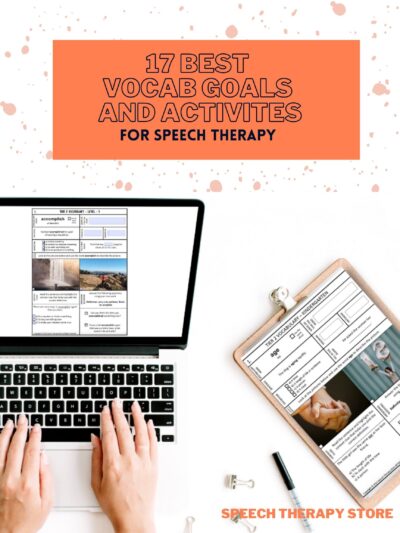
Expressive Language: Vocabulary Goals Speech Therapy
Visual cues.
Given 5 words with visual cues, STUDENT will define the word correctly with 80% accuracy in 4 out of 5 opportunities.
Common Objects or Visual Prompts
Given a common object or visual prompts, STUDENT will use 2-3 critical features to describe the object or picture with 80% accuracy in 4 out of 5 opportunities.
Use New Words
Given an emotional expression picture or story, STUDENT will use vocabulary to clearly describe the feelings, ideas, or experiences with 80% accuracy in 4 out of 5 opportunities.
Identify Similar Words – Synonyms and Antonyms
Given an object, picture, or word, STUDENT will identify synonyms with 80% accuracy in 4 out of 5 opportunities.
Given an object, picture, or word, STUDENT will identify antonyms with 80% accuracy in 4 out of 5 opportunities.
Given 5 identified words in sentences, STUDENT will provide a synonym/antonym with 80% accuracy in 4 out of 5 opportunities.
Given a story with highlighted words, STUDENT will provide a synonym/antonym for each highlighted word with 80% accuracy in 4 out of 5 opportunities.
Given 10 pictures, STUDENT will match opposite pictures in pairs (i.e., happy/sad, up/down) with 80% accuracy in 4 out of 5 opportunities.
Given an object, picture, or word, STUDENT will identify the opposite with 80% accuracy in 4 out of 5 opportunities.
Describe Target Words
Given an object or picture, STUDENT will describe the object or picture by naming the item , identify attributes (color, size, etc.), function , or number with 80% accuracy in 4 out of 5 opportunities.
Reading Passage and Context Clues
Given a reading task, STUDENT will define unfamiliar words using context clues with 80% accuracy in 4 out of 5 opportunities.
Academic: Target Vocabulary Words with Root Words
Given common academic vocabulary, STUDENT will define prefix and/or suffix with 80% accuracy in 4 out of 5 opportunities.
Correct Grammar and Complete Sentence
Given common academic vocabulary, STUDENT will define the vocabulary word using a complete sentence with correct grammar with 80% accuracy in 4 out of 5 opportunities.

Receptive Language: Vocabulary Goals Speech Therapy
Given 10 common nouns, STUDENT will identify the correct noun by pointing to the appropriate picture with 80% accuracy in 4 out of 5 opportunities.
Given 10 common verbs, STUDENT will identify the correct verb by pointing to the appropriate picture with 80% accuracy in 4 out of 5 opportunities.
Given 10 common adjectives, STUDENT will identify the correct adjective by pointing to the appropriate picture (size, shape, color, texture) with 80% accuracy in 4 out of 5 opportunities.
Given 3 to 5 pictures, STUDENT will identify the category items by pointing/grouping pictures into categories with 80% accuracy in 4 out of 5 opportunities.
SEE ALSO: IEP Goal Bank Posts
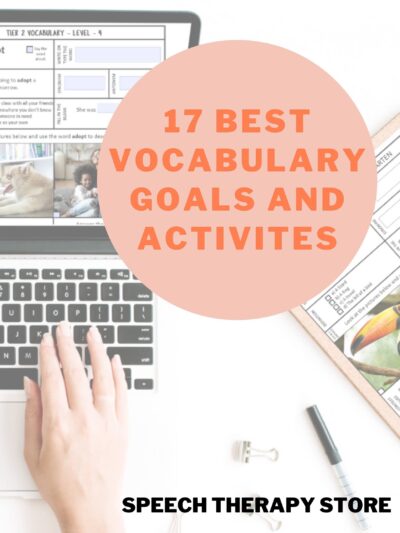
Teaching Vocabulary: Speech Therapy Sessions
When it comes to teaching vocabulary in the school setting the best practices are to teach the students the vocabulary strategies and vocabulary knowledge allowing them to learn how to define vocabulary words themselves instead of simply teaching them each new word that they then memorize.
If you’re a speech pathologist, or special education teacher, or parent and you’ve been following me for a while now you know that I love spoiling my community!
And that’s why I’m sharing with you 14 free pages from my newest resource perfect for the elementary age group!
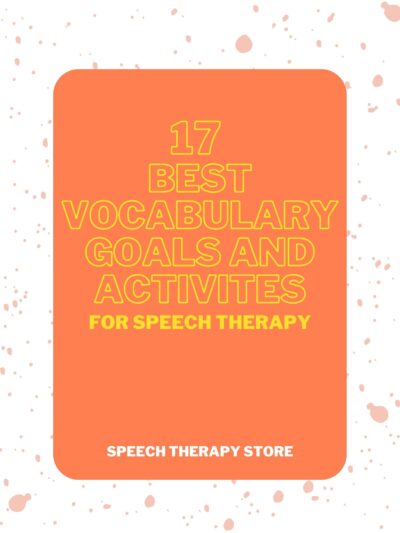
Using Targeted Words
This resource focuses on tier two vocabulary words. Tier two words are common academic words frequently used across multiple subject areas.
Teaching tier two words is an effective method and great way to work on vocabulary that students will come across in multiple textbooks.
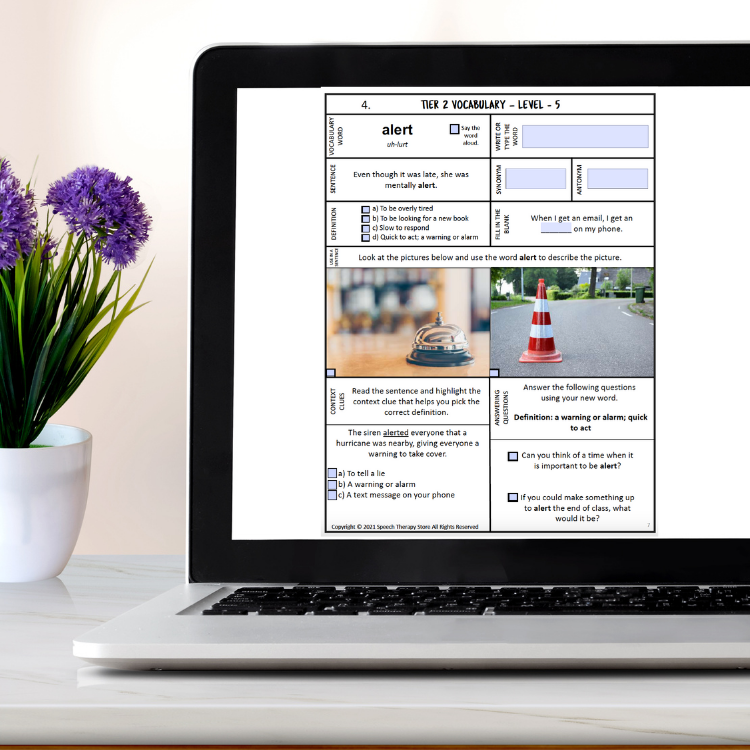
Sentence Level
Have your students practice their word at the sentence level by reading the word in a sentence, adding their word to a fill in the blank sentence, creating a sentence using their word given a visual cue, or practice by answering a question using their new vocabulary word.
Picture Icons
Including picture icons of the words is another fun way to give your students a chance to use their new vocabulary word in a sentence that they get to create.

Structured Activity
Using a structured activity with multiple exposures allows the student extra practice with one word at a time.
Consecutive Sessions
Practice over consecutive sessions for additional exposure.
Informal Assessments
The first step when starting a new goal is to collect baseline data. Simply use a couple of these worksheets as a great way to collect an informal assessment of your students’ vocabulary skills.

Language Skills
Other language tasks a student could work on are the following:
Do you have a student working on synonyms or antonyms , have a student working on using vocabulary words in a sentence , have a student working on describing a picture , have a student working on context clues , have a student working on defining new vocabulary words , have students answering questions ?
No problem all these students can be working from the same worksheet!
Core Vocabulary Words: Free Activities List
Are you in need of additional free vocabulary activities? I’ve done the searching for you!
After downloading my free 14 vocabulary worksheets above be sure to check out the following resources for even more vocabulary activities to help get you started on your child’s iep vocabulary goals.

SEE ALSO: 432+ Free Measurable IEP Goals and Objectives Bank
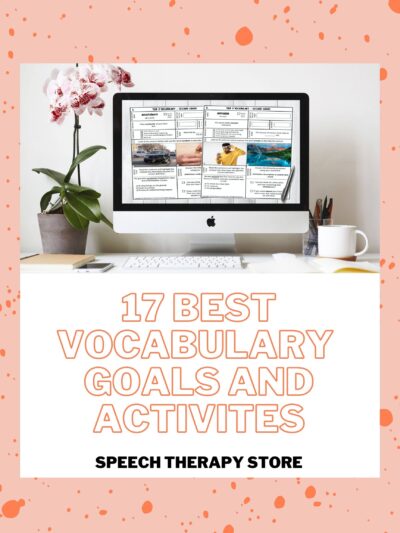
Picture Books
Using picture books can be a fun way to discuss vocabulary words with younger students as you discuss the pictures in the book together.
- Interactive Vocab Book: Mother’s Day Freebie by Jenna Rayburn Kirk – This interactive book uses velcro words so students can match the words to the correct page. There are extra sentence strips to support practicing sentences, describing functions, and describing locations.
- Questions and Vocab, When I was Little: A 4 Year Old’s Memoir of her Youth by Jennifer Trested – This is a great book to use at the end of the year. This freebie includes depth of knowledge questions, vocab, vocabulary pictures, and definitions for each vocabulary word.
- Measurement and Data Vocabulary Book – FREE – Kindergarten Math Center by Keeping my Kinders Busy – This vocab book helps teach vocabulary surrounding the Common Core Kindergarten Measurement and Data Math Unit. It’s easy to prep – just print and the students can trace and color the pictures!
- Interactive Vocabulary Books: Helping at Home by Jenna Rayburn Kirk – This book targets vocabulary, grammar, and language by using velcro pieces to match pictures to words. It keeps little hands busy and is great for preK – first grade!
Correct a Simple Sentence
Practice vocabulary words by correcting a simple sentence to use their vocabulary word correctly.
- Editing Simple Sentences – Winter Sentences by Breaking Barriers – These are winter-themed sentences to help your students learn the editing process. 3 levels help with differentiation and skill-building!
- Concept of Words Simple Sentence Writing by Teachers R US – This activity includes 5 worksheets to help students practice the concept of words, and sight words. It is great for group work or individual work!
Create Complex Sentence
Another fun activity for practicing new vocabulary words is to create a complex sentence with your new words.
- Complex Sentence Vocab! By J-Mar – This is an editable google doc to be used with your vocabulary units. Students can roll a dice that prompts them to use specific conjunction around their vocabulary word.
- Word Work: Practice using Vocab to make Compound and Complex Sentences by Academic Language Central – In these freebies, students are prompted to write compound and complex sentences using their vocab words
Single Word
Practice one word at a time with multiple exposures to using the word in a sentence or to describe a picture.
- Prefix Google Slides Word Search by Literacy Tales – Practice reading, vocabulary and sight words virtually!
- Read and Draw Single Word Vocabulary Printable: PIG by Read & Draw – This is a fun, no-prep activity to help your students remember everyday vocabulary words! (This creator has multiple words!)
- Arctic Animals Word Wall and Vocabulary Matching by ReadingisLove – There are 2 ways to practice vocabulary words in this winter-themed set: a word wall and vocab matching. This is fun and interactive!
Multiple Meaning Words
Using multiple meaning words is another great way to work on your student’s vocabulary skills.
- 193+ Multiple Meaning Words Grouped by Grade + Free Worksheets by Speech Therapy Store – Enjoy this awesome freebie I’ve created with almost 200 multiple meaning words to practice your student’s vocabulary skills.
- Multiple Meaning Word Task Cards – Intermediate Grades! Test Prep by the Owl Spot – This will give your students the chance to practice with word meaning in context. There are 32 task cards and an answer sheet.
- Which Definition Is It? (Multiple Meaning Words w/ Context Clues) by Ciera Harris Teaching – This activity helps students use context clues to figure out the definition of a multiple-meaning word!
Structured Language Activities
You can also work on a language task and simply focus on the vocabulary words as you work through a language activity for more vocabulary practice.
- Follow the Clues: St Patrick’s Day Edition (A Descriptive Language Game) FREEBIE by The Speech Path for Kids – This freebie promotes descriptive language skills while following a St Patricks Day theme!
- What’s Different? Language Activity for Fall by Keeping Speech Simple – This fall-themed, engaging activity promotes descriptive, specific language skills!
Younger Students
Here are a few vocabulary activities that would be perfect for working on with your younger students.
- Back to School Smashmat – Preschool Speech and Language Therapy Activity by Homemade Speech and Language – This freebie targets so many learning areas for PreK and first such as early intervention, speech and language targets, and play skills!
- Caps for Sale Vocabulary by dayle timmons – Read this popular children’s book and identify 6 Tier Two vocabulary words as you read aloud!
- Crossword Puzzle: Animals, Objects, Fruits Vocabulary (Colorful picture clues) by The Mochi Lab – Use these fun, interactive crosswords as an easy way to learn vocabulary!
These would also be perfect for your younger students working on cvc vocabulary tier one words, such as the words cat, bat, or dog.
- Free Phonics Worksheets – Letter Sounds – CVC Words – Beginning Initial Sounds by These are fun, free and interactive worksheets for students to practice CVC words!
- FREE CVC Words Worksheets: No Prep Write Cut and Paste Activity for Word Work by Adapting for Autism – Use these 4 Worksheets to practice reading, writing, vocab and fine motor skills!
- CVC Word Family ‘AT’ No Prep Phonics Printables FREEBIE by Tweet Resources – This freebie focuses on ‘at’ words!
SEE ALSO: 193+ Multiple Meaning Words Grouped by Grade + Free Worksheets
Communication device.
Do you have students using communication devices or boards? Here are a few premade boards to work on different vocabulary words such as expressing likes and dislikes, classroom vocabulary, as well as outside bug vocabulary.
- AAC Core Vocabulary Activities | No Print Speech Therapy | Distance Learning by Speech and Language at Home – Use this core board to have your students discuss their opinions “like” and “don’t like”.
- Core Vocabulary Classroom Labels for Autism and Special Education by The Structured Autism Classroom – Add these core vocabulary words throughout your classroom to help encourage their use throughout the school day.
- AAC Core Vocabulary Freebie | Interactive Books Speech Therapy | Look Outside by Speech and Language at Home – Get outside with your child or student and enjoy working on your student’s bug vocabulary words
Comprehension Questions and WH Questions
Answering comprehension questions and wh questions is another great way to work on vocabulary skills.
- Free Kindergarten Reading Comprehension and Questions by Teaching Biilfizzcend – This is 20 free, fun and interactive reading passages to practice comprehension.
- Free Reading Comprehension Passages & Questions by Mrs. Thompson’s Treasures – This free resource is for grades K- 4, and focuses on engaging students with the text and proving their answers!
- FREEBIE!! WH-Questions Pizza Party! Game for Speech therapy – 90 questions by Miss V’s Speech World – This is a fun and interactive game to get students practicing WH- and HOW- Questions. There are 90 question cards.
Data Collection
If you’re in need of data tracking forms while working on your student’s vocabulary goals for speech therapy then be sure to check out my IEP goal data tracking for progress monitoring forms .
Or if you simply want a list of data sheets to choose from then be sure to check out my list of 35 free speech therapy data sheets roundup .
IEP Goal Bank
Want an even bigger speech therapy goal bank? Don’t worry I’ve got you covered!
Be sure to check out my IEP goal bank made specifically for a speech-language pathologist covering even more language disorder areas such as final consonants or the phonological process of final consonant deletion. Fluency goals using easy onset and slow rate or pragmatic language goals covering communication skills, social interaction, and topic of conversation and so many more educational goals.
In Conclusion: Vocabulary Goals for Speech Therapy
I hope you’ve found this list of vocabulary goals for speech therapy to be helpful in your IEP goal writing!
Be sure to grab your free vocabulary practice pages below by filling out the form below.
Fill Out the Form Below to Download Your Free Sample Pages!
Grab your 14 free sample pages, want even more vocabulary goals for speech therapy resources.
- 430+ Free Multisyllabic Words List Activity Bundle
- 179+ Free Speech Therapy WH Questions Printable
- 133+ Categories List for Speech Therapy
- 33 Most Common Irregular Plurals Flashcards [Freebie]
Want the Best of the Bests?
Be sure to check out our most popular posts below!
- 21 Best Reinforcement Games for Speech Therapy / Teletherapy
- Best IEP Resources
- 71+ Free Social Problem-Solving Scenarios
- 432+ Free Measurable IEP Goals and Objectives Bank
- 279+ Free Speech Therapy Digital Materials
- 179+ Free Speech Therapy Wh-Questions Printable
Sunday 2nd of October 2022
I am looking vocabulary worksheets for Tier 2 kindergarten words
Melissa Berg
Monday 3rd of October 2022
Hi Yukari, You can buy the Kindergarten words here.
Do you have these vocabulary worksheets for all Tier 2 works I can purchase?
Hi Yukari, Yes, I do have a bundle that includes them all for sale. However, I only offer the entire bundle a few times a year. I'm hoping to offer the whole bundle again in November so be sure to keep an eye out for that email. All my best, Melissa
Tuesday 9th of August 2022
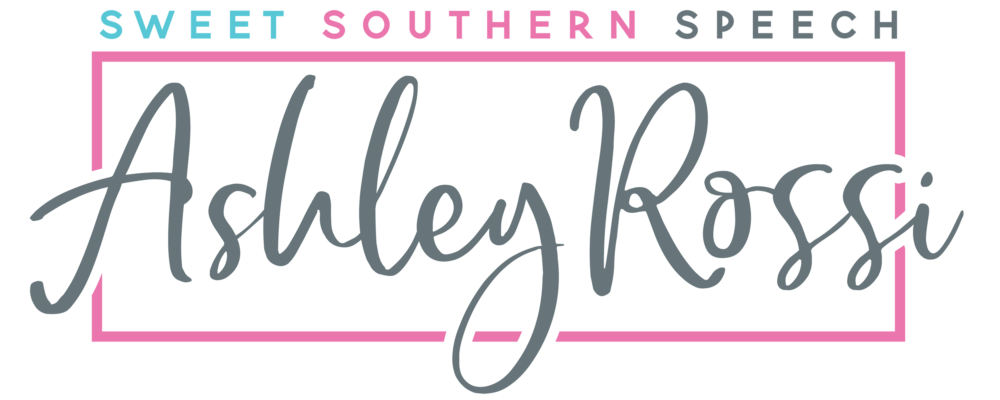
Monthly Plans
Vocabulary intervention in speech therapy.
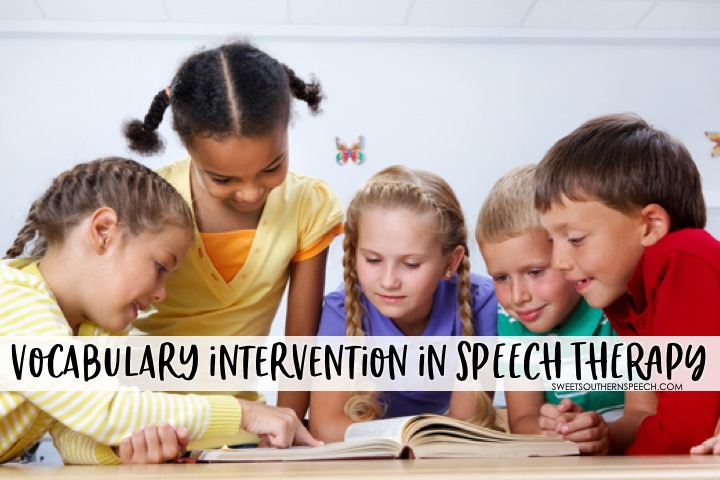
How To Improve and Take Data on Vocabulary In Speech Therapy
How many of your students have vocabulary goals for Speech Therapy? #nearlyallofthem We know our students struggle with vocabulary. We can see it in their poor reading comprehension and oral expression. Vocabulary is vitally important. But man, it’s a huge mountain to climb when faced with vocabulary as a goal. Where do we even start? Why do grade level lists vary so much? How in the world do I take data on it? Let’s look at what the research says on best practices for vocabulary intervention in Speech Therapy. We CAN improve and take data on vocabulary!
Research on Teaching Vocabulary:
“The most effective vocabulary teaching methods included both definitional and contextual information in their programs, involved the students in deeper processing, and gave the students more than one or two exposures to the to-be-learned words.” Stahl and Fairbanks (1986)
Children with LI need many exposures to achieve complete word learning, and they also require continued follow-through to maintain their vocabulary gains ( Riches et al., 2005 ; Rice et al., 1994 )
“Children in Grades 3–5, with reading fluency in the normal range but poor reading comprehension, and found that “students who were taught vocabulary outperformed… students who were exposed only to the target words in text,” even if they were exposed to the word several times. Vocabulary teaching strategies included :
- determine the part of speech (e.g. noun vs. adjective)
- analyze for morphological clues (e.g. “replacing un with not to figure out unclear means not clear ”)
- look for context clues
- and, if the above three methods were inadequate, look the word up
Their finding—that children with reading difficulties require explicit vocabulary instruction to make progress—has been supported by previous studies as well. Elleman, A.M., Steacy, L.M., Olinghouse, N.G., Compton, D.L. (2017). Examining Child and Word Characteristics in Vocabulary Learning of Struggling Readers. Scientific Studies of Reading . Advance online publication. doi:
“A systematic review examines how vocabulary instruction impacts reading comprehension. The authors looked at intervention outcomes from 36 studies of Pre-K through 12th grade children, with and without disabilities, some English language learners, and all subject to vocabulary intervention. The results guide us to:
- Teach word meanings to support comprehension. Even just a little definition instruction was found to be helpful, compared to none at all.
- … however, just being told the definition of a word isn’t enough . Students need to be actively engaged in thinking about the word meaning.
- Studies easily find an impact on taught vocabulary . What we don’t know is if vocabulary intervention can broadly impact reading comprehension.
- There also isn’t strong data to indicate that teaching a strategy (instead of specific words; e.g. using context clues) can broadly impact reading comprehension.” Wright, T.S., Cervetti, G. (2016). A systematic review of the research on vocabulary instruction that impacts text comprehension. Reading Research Quarterly . Advance online publication. doi: 10.1002/rrq.163.
Strategies for Vocabulary Intervention in Speech Therapy:
- Give a child-friendly definition. Dictionary definitions are NOT effective method for learning new word meaning. In fact, this strategy may result in students interpreting the wrong meaning . So, what does this look like in a typical speech session? As you are reading a picture book and come across new words, quickly provide a one or two word student-friendly definition. Use this for post-reading activities as well.
- Increase depth of word meaning. Synonyms, Antonyms, and non-examples using the Frayer Model is an effective strategy for encouraging a deeper processing of word meaning.
- Expand meaning to new contexts. Once a student-friendly definition is created, offer other examples of the use of that word. Also asking and answering additional questions related to that target word and offering additional examples and explanations are proven ways to build vocabulary depth of meaning. In speech sessions, this can be done through partner discussions or therapist-students discussions at the conversation level.
- Semantic Mapping. Put the target word in a circle and brainstorm all the words related to it. Think of describing words, synonyms, or relationships to that word.
- Context Clues. Find words in the story or passage that give clues to derive meaning.
- Semantic Feature Analysis. Make a matrix chart with +/- and where related words are listed vertically and possible features are listed across the top.
- Venn Diagrams of related concepts. Compare common characteristics of words.
- Study roots and affixes.
- Engage and expand the complexity of conversations. Specifically with preschoolers, this strategy is most effective! When the child speaks, recast to expose them to rare words. Expand their utterance and ask open-ended questions to encourage further conversation.
What words to select:
Select meaningful words. Don’t download random “grade level” lists. Look to the student’s curriculum for literature they are reading, math vocabulary, or other subject-related academic vocabulary.
Find high quality picture books and engage in dialogic reading (Interactive Storybook Reading). If you need example, look at the seasonal books I recommend and use in my language bookmarks . In each of those, I pull out rich vocabulary I feel is worth going deeper with as I read and during post-reading activities.
Use thematically or taxonomy-related words. Children learn words that fit into a category they already know.
Provide multiple exposures to the words. The goal is to improve the depth (how well its understood) of vocabulary knowledge not just the breath (how many words).
Finally, after you have chosen words your students need to work on, engage them in the activities mentioned above to deepen their vocabulary knowledge.
Taking Data on Vocabulary in Speech Therapy:
You can preview vocabulary words to see how well a student understands them. As I’m reading a passage or picture book to students, I will stop briefly and probe for understanding of word meaning. I make note of words they understand or not.
After your word study work, you can assess and take data on vocabulary:
- their ability to use the word in a sentence
- student-friendly definition
These are the strategies I use in my therapy sessions. What have you found to be successful?
Additional references: Hadley, E. B., Dickinson, D. K., Hirsch-Pasek, K., & Golinkoff, R. M. (2018). , Ruston, H. & Schwanenflugel, P. (2010). , Dickinson, D. K., Nesbitt, K. T., Collins, M. F., Hadley, E. B., Newman, K., Riveria, B. L., …Hirsh-Pasek, K. (2019).
https://www.theinformedslp.com/
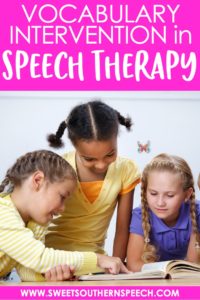
You might also like
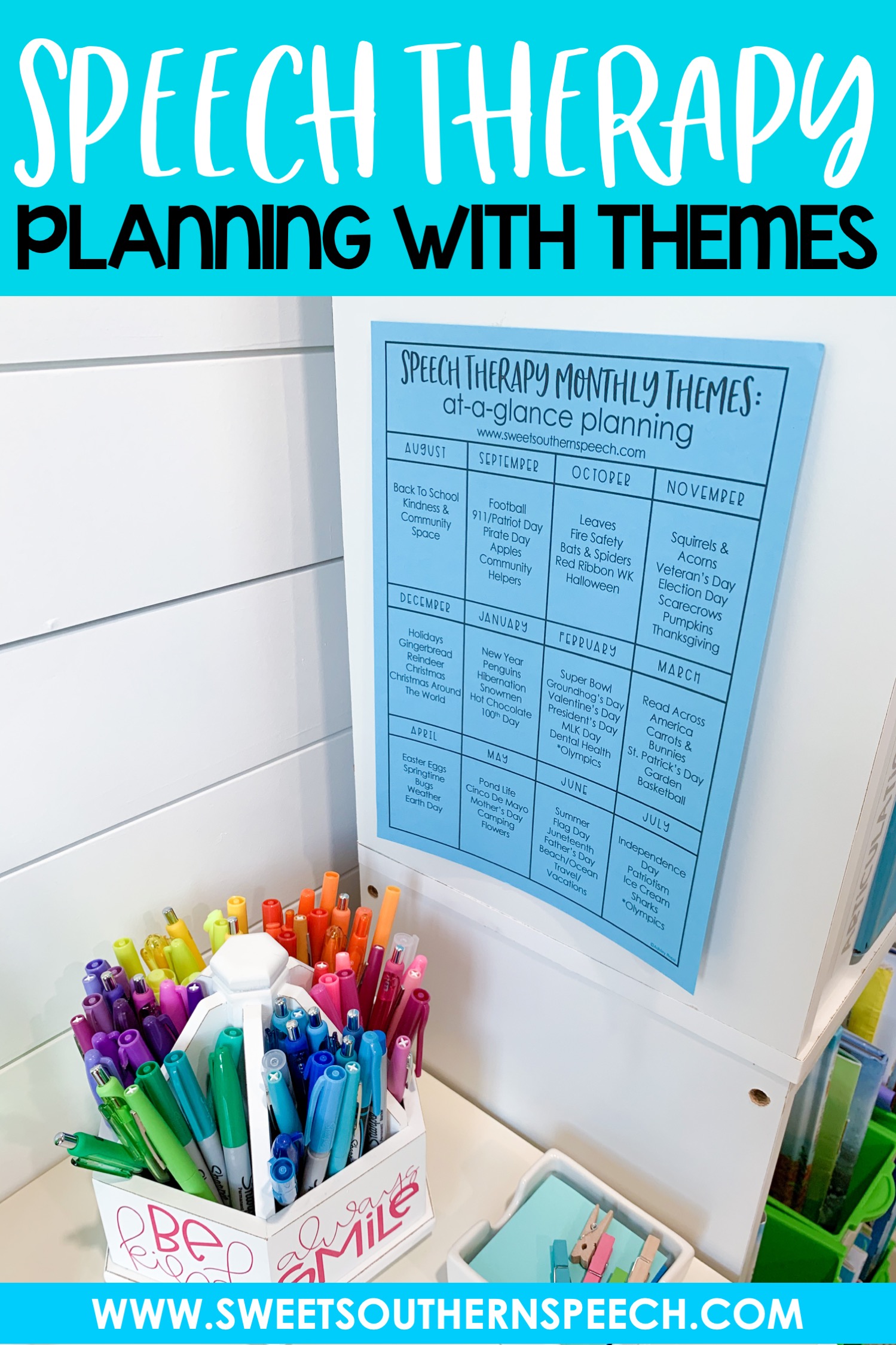
Creating Speech Therapy Lesson Plans for Themes
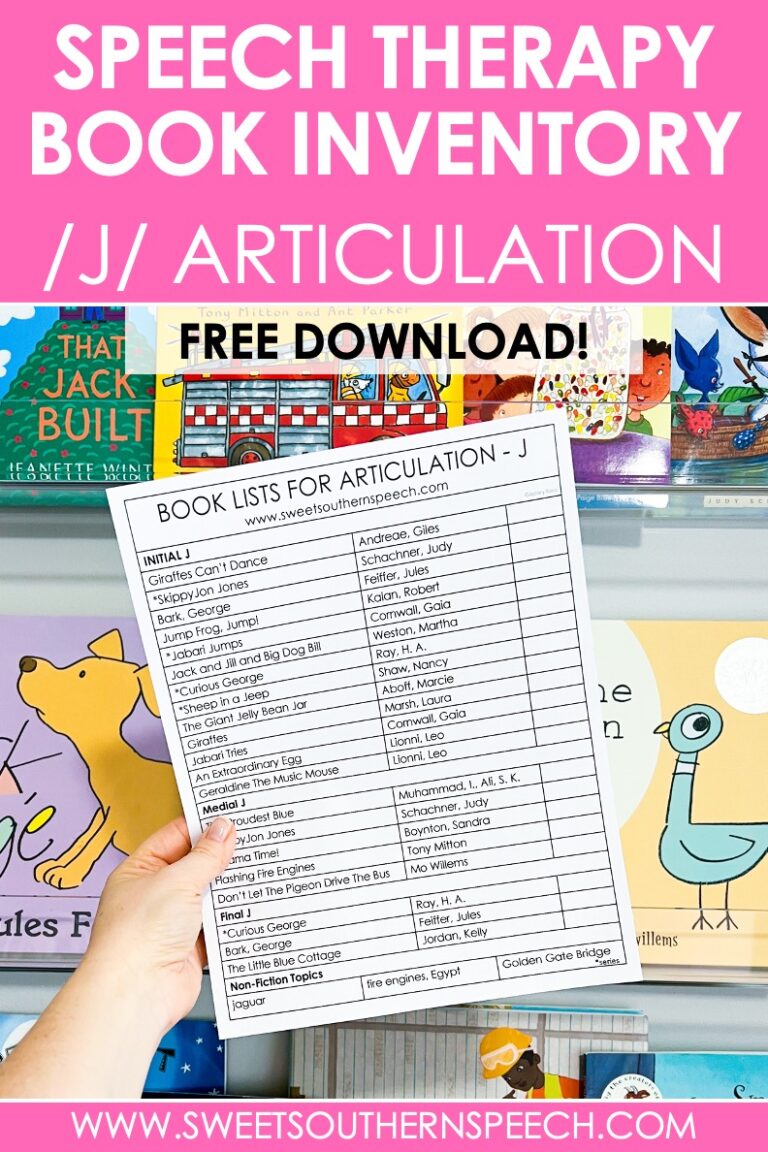
/J/ Book List for Articulation Therapy
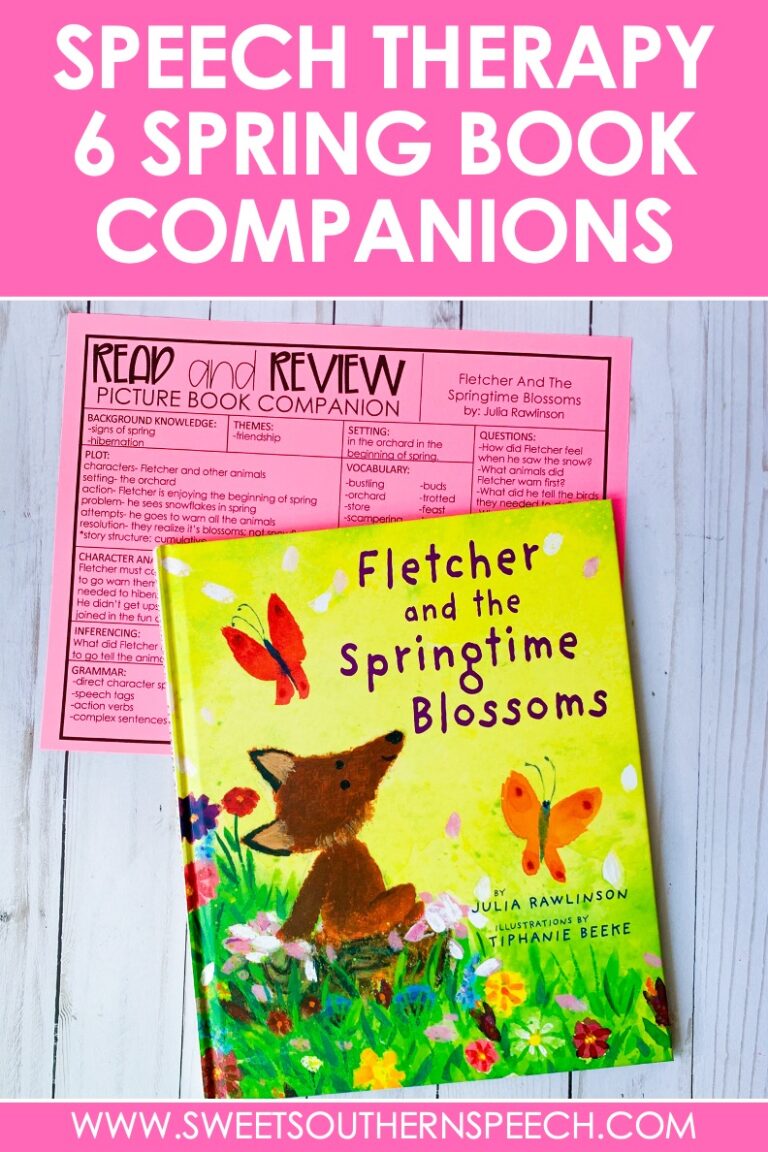
Spring Book Companions For Speech Therapy
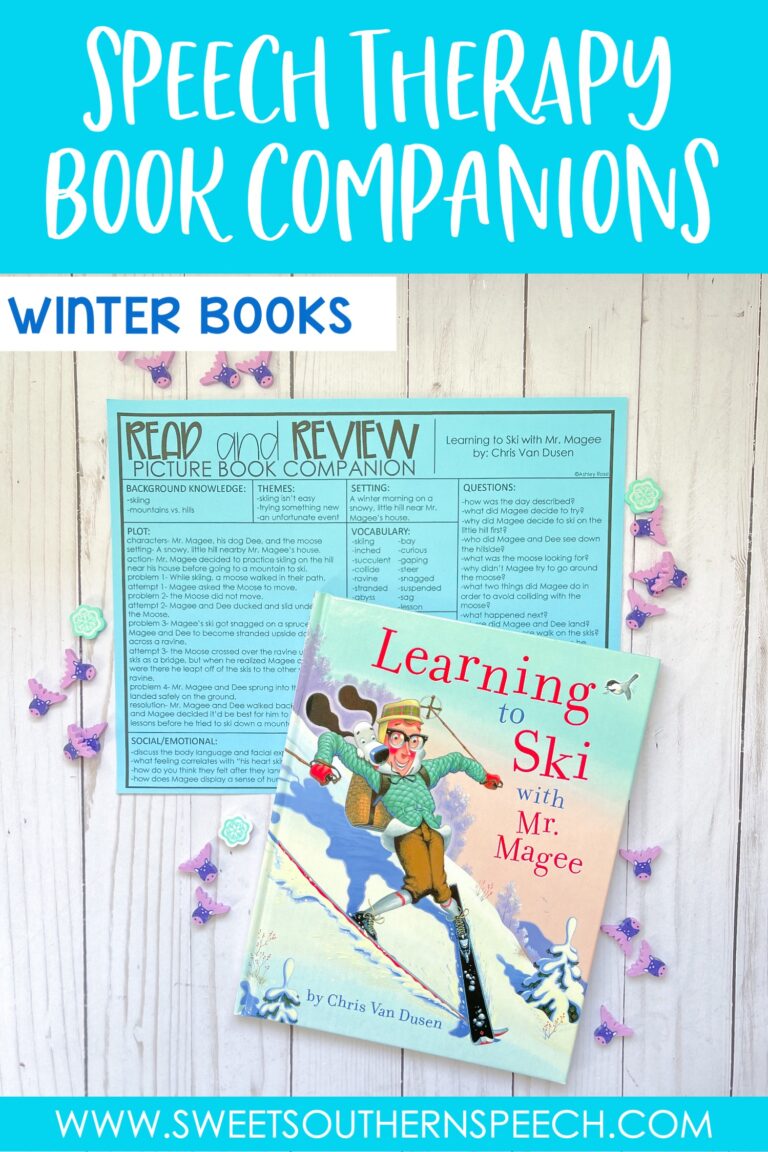
Winter Book Companions For Speech Therapy
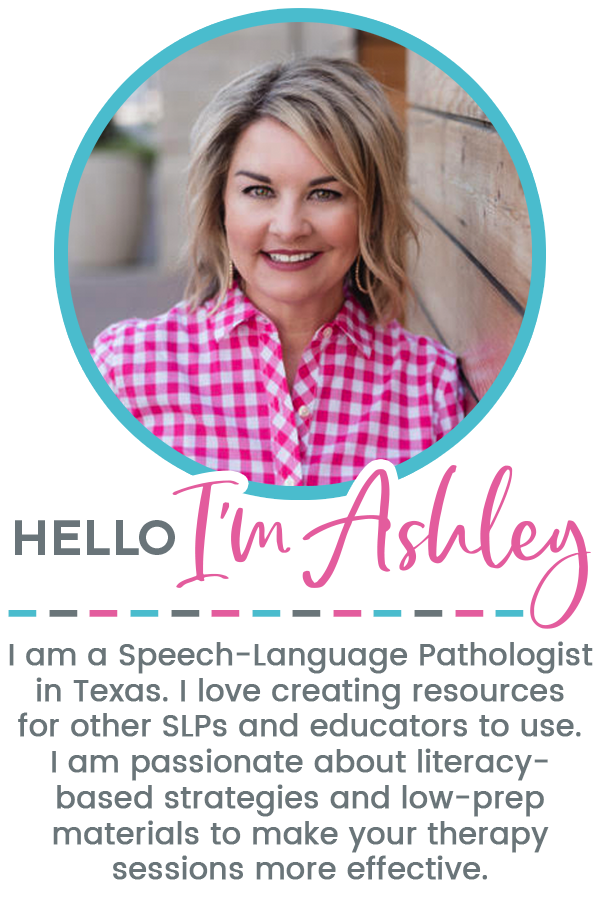
Latest on Instagram

ashleyrossislp
🗣 Private Practice SLP 📚 Literacy-Based Speech Therapy 🖥 Blogger • Product Creator 🔻click for all my LINKS

Evidence-Based Blog and Materials for SLPs!
- $ 0.00 0 items
Effective Vocabulary Instruction: What SLPs Need to Know

Teachers and SLPs frequently inquire regarding effective vocabulary instruction methods for children with learning disabilities. However, what some researchers have found when they set out to “examine how oral vocabulary instruction was enacted in kindergarten” was truly alarming.
In September 2014, Wright and Neuman , analyzed about 660 hours of observations over a course of 4 days (12 hours) in 55 classrooms in a range of socio-economic status schools.
They found that t eachers explained word meanings during “teachable moments” in the context of other instruction.
They also found that teachers:
- Gave one-time, brief word explanations
- Engaged in unsystematic word selection
- And spent minimal time on vocabulary devoted to subject areas (e.g., science and social studies in which word explanations were most dense)
They also found an economic status discrepancy, namely:
Teachers serving in economically advantaged schools explained words more often and were more likely to address sophisticated words than teachers serving in economically disadvantaged schools .
They concluded that “ these results suggest that the current state of instruction may be CONTRIBUTING to rather than ameliorating vocabulary gaps by socioeconomic status .”
Similar findings were reported by other scholars in the field who noted that “teachers with many struggling children often significantly reduce the quality of their own vocabulary unconsciously to ensure understanding.” So they “reduce the complexity of their vocabulary drastically.” “For many children the teacher is the highest vocabulary example in their life. It’s sort of like having a buffet table but removing everything except a bowl of peanuts-that’s all you get “. (Excerpts from Anita Archer’s Interview with Advance for SLPs )
It is important to note that vocabulary gains are affected by socioeconomic status as well as maternal education level. Thus, children whose family incomes are at or below the poverty level fare much more poorly in the area of vocabulary acquisition than middle class children. Furthermore, Becker (2011) found that children of higher educated parents can improve their vocabulary more strongly than children whose parents have a lower educational level.
Limitations of Poor Readers :
Poor readers often lack adequate vocabulary to get meaning from what they read. To them, reading is difficult and tedious, and they are unable (and often unwilling) to do the large amount of reading they must do if they are to encounter unknown words often enough to learn them.
Matthew Effect, “rich get richer, poor get poorer”, or interactions with the environment exaggerate individual differences over time. Good readers read more, become even better readers, and learn more words. Poor readers read less, become poorer readers, and learn fewer words. The vocabulary problems of students who enter school with poorer limited vocabularies only exacerbate over time.
However, even further exacerbating the issue is that students from low SES households have limited access to books. 61% of low-income families have NO BOOKS at all in their homes for their children ( Reading Literacy in the United States: Findings from the IEA Reading Literacy Study, 1996. ) In some under-resourced communities, there is ONLY 1 book for every 300 children. Neuman , S., & Dickinson, D. (Eds.). (2006) Handbook of Early Literacy Research (Vol. 2) . In contrast, the average middle class child has 13+ books in the home.
The above discrepancy can be effectively addressed by holding book drives to raise books for under privileged students and their siblings. Instructions for successful book drives HERE .
So what are effective methods of vocabulary instruction for children with language impairments?
According to (NRP, 2000) a good way for students to learn vocabulary directly is to explicitly teach them individual words and word-learning strategies .
For children with low initial vocabularies, approaches that teach word meanings as part of a semantic field are found to be especially effective (Marmolejo, 1991).
Many vocabulary scholars (Archer, 2011; Biemiller, 2004; Gunning 2004, etc.) agree on a number of select instructional strategies which include:
- Rich experiences/high classroom language related to the student experience/interests
- Explicit vs. incidental instruction with frequent exposure to words
- Establishing word relationships
- Word-learning strategies to impart depth of meaning
- Morphological awareness instruction
Response to Intervention: Improving Vocabulary Outcomes
For students with low vocabularies, to attain the same level of academic achievement as their peers on academic coursework of language arts, reading, and written composition, targeted Tier II intervention may be needed.
Tier II words are those for which children have an understanding of the underlying concepts, are useful across a variety of settings and can be used instructionally in a variety of ways
According to Beck et al 2002, Tier II words should be the primary focus of vocabulary instruction, as they would make the most significant impact on a child’s spoken and written expressive capabilities.
Tier II vocabulary words
- High frequency words which occur across a variety of domains conversations, text, etc.
- Contain multiple meanings
- Descriptive in nature
- Hostile, illegible, tolerate, immigrate, tremble, despicable, elapse, etc.
According to Judy Montgomery “You can never select the wrong words to teach.”
Vocabulary Selection Tips:
- Make it thematic
- Embed it in current events (e.g., holidays, elections, seasonal activities, etc)
- Classroom topic related (e.g., French Revolution, the Water Cycle, Penguin Survival in the Polar Regions, etc)
- Do not select more than 4-5 words to teach per unit to not overload the working memory (Robb, 2003)
- Select difficult/unknown words that are critical to the passage meaning, which the students are likely to use in the future (Archer, 2015)
- Select words used across many domains
Examples of Spring Related Vocabulary
Adjectives:
- Flourishing
- Regeneration
Idiomatic Expressions :
- April Showers Bring May Flowers
- Green Thumb
- Spring Chicken
- Spring Into Action
Creating an Effective Vocabulary Intervention Packets and Materials
Sample Activity Suggestions:

- Vocabulary Page (list of story embedded words their definitions, and what parts of speech the words are)
- Multiple Choice Questions or Open Ended Questions Page
- Crossword Puzzle Page
- Fill in the Blank Page
- True (one word meaning) Synonym/Antonym Matching Page
- Explain the Multiple Meaning of Words Page
- Create Complex Sentences Using Story Vocabulary Page
Intervention Technique Suggestions :
1.Read vocabulary words in context embedded in relevant short texts
2.Teach individual vocabulary words directly to comprehend classroom-specific texts (definitions)
3.Provide multiple exposures of vocabulary words in multiple contexts, (synonyms, antonyms, multiple meaning words, etc.)
4.Maximize multisensory intervention when learning vocabulary to maximize gains (visual, auditory, tactile, etc.)
5.Use multiple instructional methods for a range of vocabulary learning tasks and outcomes (read it, spell it, write it in a sentence, practice with a friend, etc.)
6.Use morphological awareness instruction (post to follow)
- An ability to recognize, understand, and use word parts (prefixes, suffixes that “carry significance” when speaking and in reading tasks
Conclusion :
Having the right tools for the job is just a small first step in the right direction of creating a vocabulary-rich environment even for the most disadvantaged learners. So Happy Speeching!

Helpful Smart Speech Resources :
- Creating A Learning Rich Environment for Language Delayed Preschoolers
- Vocabulary Intervention: Working With Disadvantaged Populations
- The Water Cycle: A thematic language activity packet for older students
- The Checklists Bundle
- Narrative Assessment and Treatment Bundle
- Social Pragmatic Assessment and Treatment Bundle
- Assessment Checklist for Preschool Children
- Assessment Checklist for School Children
- Auditory Processing Deficits Checklist for School Aged Children
4 thoughts on “ Effective Vocabulary Instruction: What SLPs Need to Know ”
This is a fantastic blog post! Vocabulary instruction is one of my professional goals this year, and I am very excited to see so much research included in one place. I really appreciate you gathering so many strategies that can be implemented in the classroom. Thank you!
[…] a strong vocabulary is key to success in all academic areas. This article brilliantly underlines the importance of effective vocabulary instruction and gives pra… for direct vocabulary instruction. In the article, the author quotes vocab expert Dr. Anita […]
[…] classrooms of low achieving students. This allowed me to research quite a bit regarding the principles of vocabulary teaching as well as gave me an opportunity to adapt and design my own vocabulary intervention […]
[…] I noted in my previous post on effective vocabulary instruction (HERE): “teachers with many struggling children often significantly reduce the quality of their own […]
You must be logged in to post a comment.
- Adolescents (28)
- Ankyloglossia (1)
- APD Validity (7)
- App Review (18)
- Articulation (17)
- Assessment (118)
- Autism (19)
- behavior strategies (14)
- Bell Curve Charting (3)
- Bilingual (17)
- Blogging About Research (25)
- Book Companion (10)
- CEUs/CMHs (4)
- Checklist (23)
- Childhood Apraxia of Speech (6)
- Clinical Assessment (19)
- Clinical Fellows (1)
- CMH Quiz (1)
- Context Clues (3)
- Contextual Intervention (8)
- Controversial Practices in Health Care (7)
- Critical Thinking (22)
- Cues and Prompts (4)
- Development milestones (16)
- Developmental Disabilities (12)
- Differential Diagnosis (20)
- Down Syndrome (6)
- Dysgraphia (7)
- Dyslexia (35)
- Dyslexia Assessment (12)
- Dyslexia/Reading Disability (30)
- Early Intervention (18)
- Elementary (32)
- emotional and behavioral disturbances (34)
- Emotional Intelligence (5)
- Evidence-Based Practice (EBP) (50)
- Executive Function (15)
- Facebook (7)
- Fairy Tales (1)
- feeding (3)
- Following Directions (2)
- Fragile X Syndrome (3)
- Freebie (13)
- genetic syndromes (14)
- Giveaway (71)
- Independent Educational Evaluations (IEEs) (13)
- Insight (15)
- insurance coverage (2)
- Intake forms (6)
- internationally adopted children (28)
- Kindergarten (11)
- language delay (74)
- Language Disorder (68)
- language stimulation (30)
- Learned Helplessness (1)
- Learning Disability (55)
- Life Skills (3)
- listening comprehension (29)
- Literacy (42)
- Metacognition (4)
- Metalinguistics (12)
- Middle School (24)
- Morphological Awareness (8)
- Motor Speech Disorders (5)
- multicultural (24)
- Multisensory Stimulation (9)
- Narratives (10)
- News Release (44)
- NJAC 6A:14-3.6 (1)
- Nonfiction Text (2)
- orofacial assessment (4)
- Parent Consultation (4)
- Parent Tips (2)
- Phonemic Awareness (24)
- Phonics (9)
- Phonological Awareness (16)
- Picture Books (11)
- preschoolers (52)
- Problem Solving and Verbal Reasoning (34)
- Processing Disorders (25)
- Professional Consultation (2)
- Professional Development (3)
- Psychiatric Impairments (3)
- Reading Comprehension (20)
- Reading Fluency (17)
- Report Writing Tips (12)
- resource websites (34)
- Review (37)
- Rewards (1)
- Russian (6)
- Science of Reading Literacy Certificate for SLPs (1)
- Screening (1)
- Search Tips (2)
- Sequencing (2)
- Severe Disabilities (12)
- SLP Efficiency Bundles (3)
- Smart Speech Therapy Article (77)
- Social Communication (25)
- social pragmatic language (70)
- Social Thinking® Products (2)
- Special Education Disputes (14)
- speech language pathology (209)
- Speech-Language Report Tutorials (12)
- SPELL-Links/Learning By Design (3)
- Spelling (12)
- stuttering (5)
- Summer Learning Loss (1)
- Test Review (16)
- Thematic Intervention (13)
- Toddlers (12)
- Tongue Tie (1)
- Translanguaging (5)
- Treatment Suggestions (112)
- Trivia Night (5)
- Video Modeling (1)
- Vocabulary (42)
- Wh- Questions (2)
- word-finding (12)
- Writing (16)
Different By Design Learning
with Shawna Wingert
20 Vocabulary Goals For Speech Therapy: Practical Examples For Learning
When creating vocabulary goals for speech therapy, it can be tempting to create a checklist and begin practice drills. The very best approach however, exposes learners to vocabulary practice in everyday life, and gives them strategies for communicating in real life scenarios.

Evidence Based Strategies To Strengthen Vocabulary Skills
Table Of Contents
Research shows that a child’s vocabulary skills increase over time and exposure.
Varying the therapeutic techniques we use can help increase the overall exposure to and retention of vocabulary words. Here are the top 5 research based recommendations to help increase vocabulary mastery:
- Encouraging the learner to use the vocabulary word expressively
- Multiple exposures to the targeted vocabulary words (Hadley et al., 2018)
- Providing explicit, learner-friendly definitions (Hadley et al., 2018)
- Making connections between known words and new words (Stahl, 2006)
- Writing the word and also, seeing it written in a sentence (Kucan, 2012)
While I have never met a child who didn’t want to master vocabulary, there are several factors that contribute to difficulties. One of the greatest challenges is in the lack of natural exposure to the words themselves.

Techniques For Practicing Vocabulary In Speech Therapy Sessions
In order to help the learner within the context of a speech therapy session, it is important to encourage the learner to interact with a new word in as many modalities as possible.
Various techniques for practicing a new vocabulary word and determining vocabulary goals include:
- Thinking about other words that mean the same thing
- Discussing why the word conveys a deeper meaning than other synonyms
- Using the word in a silly sentence
- Write the word
- Draw the word in a picture
- Trace the word with fingers in sand or with raised, dotted paper
- Hear the word said in the course of several sessions
- Read the vocabulary word in differing materials

Vocabulary Goals For Speech Therapy: Practical Examples For Learning
These sample goals allow for increased learner engagement with target vocabulary words:
- Learner will use synonym or antonym based context clues as a clue to the meaning of a word and define the word 70% of given opportunities.
- Learner will demonstrate understanding of words, including math vocabulary terms, by relating them to their opposites (antonyms) and to words with similar but not identical meanings (synonyms) in 80% of opportunities.
- When given a cue, Learner will define a vocabulary word while using a complete sentence in 70% of opportunities.
- Given one verbal prompt, learner will explain a multiple meaning word using context clues in 70% of opportunities.
- Learner will show ability to define age-appropriate vocabulary words using synonyms, antonyms, and by completing practical activities with 80% accuracy.
- Given example words from school curriculum, learner will state the meaning of 10 different prefixes or suffixes.
- Learner will use 2-3 critical features to describe the object or picture with 80% accuracy in 4 out of 5 opportunities.
- Learner, when given an object or picture, will identify synonyms with 80% accuracy.
- Given an object, picture, or word, Learner will demonstrate the ability to identify antonyms with 80% accuracy .
- Given 10 words with visual cues, Learner will define the word correctly with 80% accuracy.
- Learner will provide a synonym or antonym with 80% accuracy when given 10 identified words in complete sentences.
- Learner will identify previously agreed upon vocabulary words as part of reading practice with 80% accuracy.
- Given an object, picture, or word, Learner will identify synonyms with 80% accuracy in 4 out of 5 opportunities.
- Using an emotional expression picture or story, Learner will clearly describe the feelings, ideas, or experiences using vocabulary words with 80% accuracy.
- Learner will match 10 opposite pictures in pairs with 80% accuracy in 4 out of 5 opportunities.
- Given an object, picture, or word, Learner will identify the opposite with 80% accuracy.
- Learner will describe an object or picture by naming the item, and demonstrating ability to identify attributes, function, or number with 80% accuracy.
- While reading, Learner will define unfamiliar words using context clues with 80% accuracy.
- Learner will define prefix and/or suffix with 80% accuracy.
- Learner will define a practiced vocabulary word using a complete sentence with 80% accuracy.
Take a look at some of these goals in action in this helpful video:
Additional Resources For Speech Therapy Goals
Looking for more support in creating appropriate goals for speech therapy?
You’ll find goals for the following:
- Expressive Language
- Receptive Language
- Articulation
- Social Pragmatic Language
all in this related post – Speech Therapy Goals: A Step By Step Guide
Shawna Wingert is a former training and development professional turned education specialist, and has homeschooled her two children for the last ten years.Shawna has written four books about homeschooling unique learners and has been featured in homeschooling discussions on Today.com, The Mighty, Simple Homeschool, My Little Poppies and Raising Lifelong Leaners.
You can find her online here at DifferentByDesignLearning.com.
Similar Posts


Speech Therapy Goals: Examples for Success In All Categories
This step by step guide has everything you need for appropriate and successful speech therapy goals. It includes sample goals for expressive and receptive language, articulation, fluency, and more. Speech Therapy: Getting Started Before a goal is created, it is essential to determine what specific area of communication is in need of support. A speech…
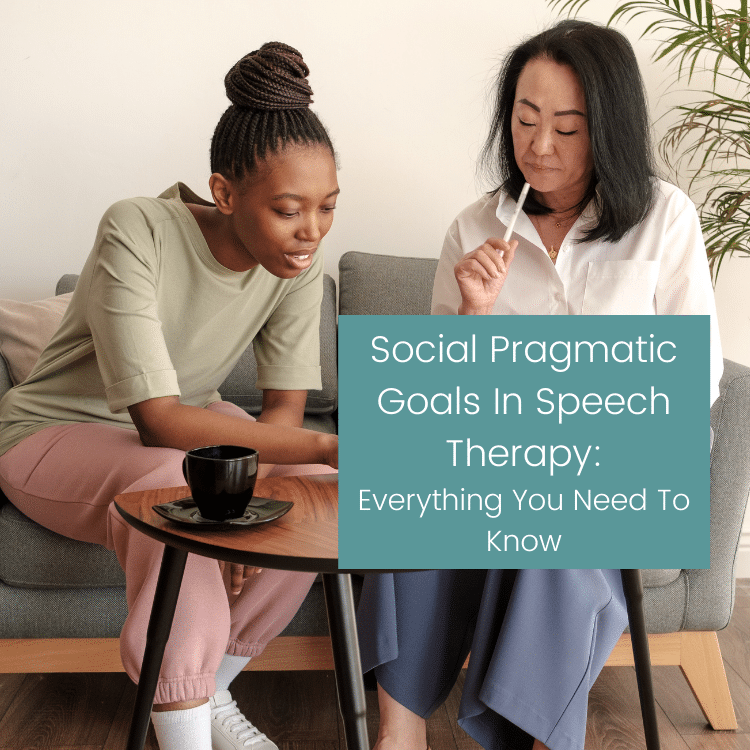
Social Pragmatic Goals In Speech Therapy: Everything You Need To Know
This overview introduces social pragmatic goals in speech therapy as well as examples of how these goals contribute to your child’s increasing social ability. When my child was first diagnosed with social pragmatic language disorder, I was not surprised. Part of my college education included a minor in communication disorders, so I was familiar with…

Occupational Therapy, Speech Therapy and Social Skills Therapy At Home
It is possible to complete occupational therapy, speech therapy, social skills therapy and CBT at home with your children. Here is everything you need to get started. My son was hiding under the chair in the doctor’s office, softly rocking and hitting his head. One minute prior, he had been sitting in the same chair,…

Speech Therapy In Middle School: Tips for Older Children
Speech therapy for an older child can be very difficult. Age appropriate and respectful activities are hard to find when your child is in middle school and approaching the teen years. The first time my youngest son completed a speech and language assessment, he was four years old. I brought him in on the recommendation…

- Literacy Based Therapy
- Speech Sounds
The Bookshelf
Resource library, how to pick vocabulary words for speech therapy.
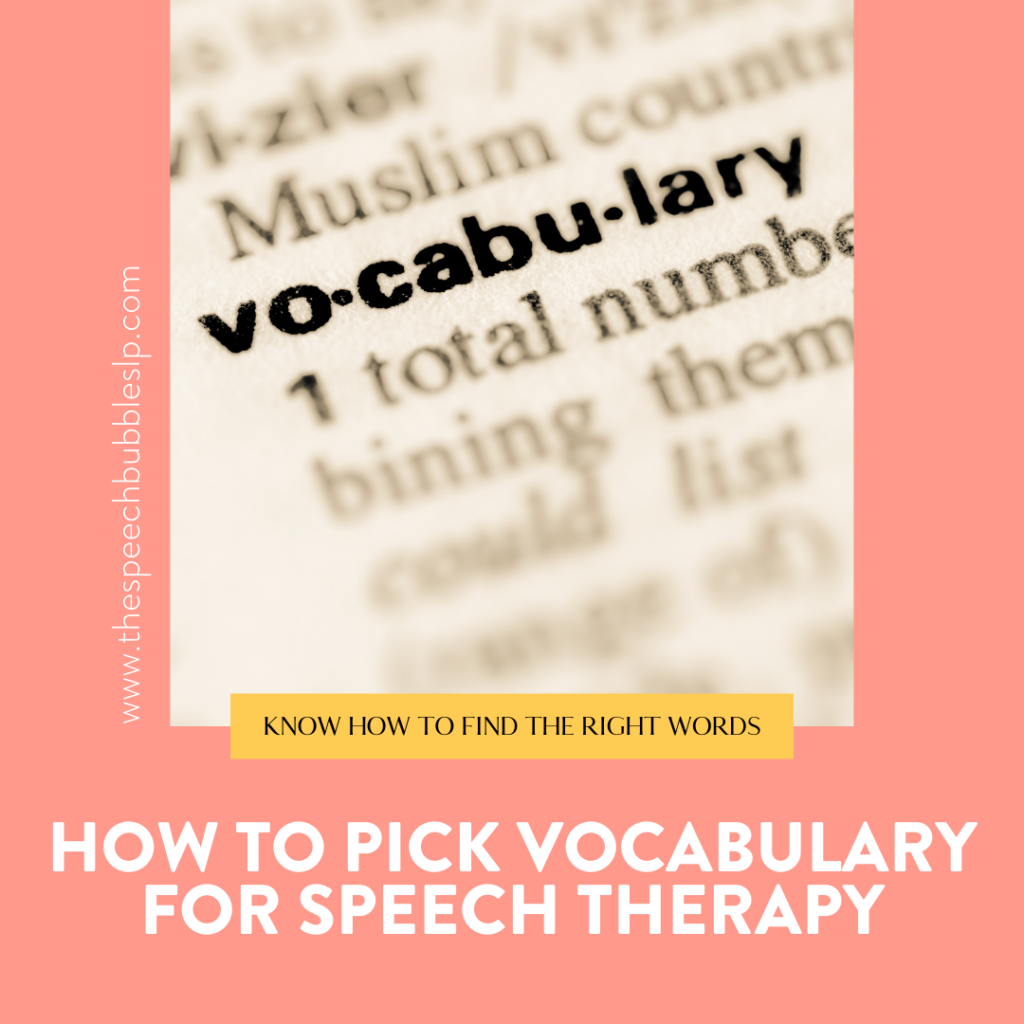
How to Pick Vocabulary Words: What words?! Whenever I had a student who needed to work on vocabulary My mind started racing, ‘What words do I pick?’ ‘What are the right words to use? ‘. When writing a goal we need to know what we are tracking. You cannot simply write with ‘classroom vocabulary’, that ain’t gonna fly if your case brought to due process.
You must have a list of the words you are going to target and track progress.
Now, there are lots of resources out there. I have read books like Bridge to Vocabulary , Bringing Words to Life , Building Academic Vocabulary , and Teaching Vocabulary and found them so valuable. These have been wonderful resources and I highly encourage you to check them out. A common theme across them all is to make the vocabulary meaningful for the child.
Explain why these words are so important,
point them out in daily living, show their actual application! Choosing the words to target when it comes to working on vocabulary doesn’t have to be an ordeal either. One of the best and most practical places to find words is to look at their academic worksheets, read the directions, and focus on the verbs. Words like arranging, summarize, incorporate, detail, etc will pop up left and right.
These are examples of tier 2, functional vocabulary words. I do not assume that the students know these words despite having been surrounded for years. So, if you’re stumped on what words to choose, start here.
“Failure to understand instructional verbs and thus what a teacher or textbook is asking of a child has the potential of creating a rift in the child’s engagement with the learning process.” Lowman et al., 2018
Now, one of the most common questions after hearing this, ‘What verbs are the best to target then?’. So here is a list of instructional verbs, common for Kindergarten to 5th grade. Please keep in mind there are soooo many words available that our students are exposed to everyday, but if you need a jumping off point, then take a look at the list below.
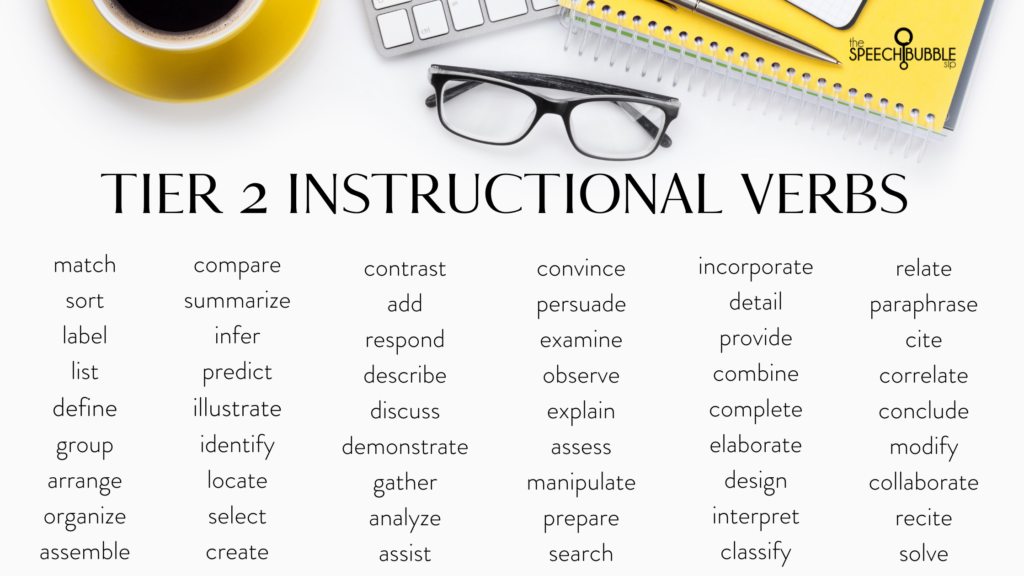
I have also used these Vocabulary Kits with a lot of success too. I simply pick a word set and that is our focus for the year. The are research based so the vocabulary chosen aligns with the same academic practicality we need. This also includes scaffolded materials as well as a pretest/post-test. You can read more about this my Teaching Vocabulary in Speech Therapy post.
So when it comes to vocabulary, don’t stress. Words your kids need surround them all you have to do is to find the best fit for them.

Lowman, J., Stone, L. T., & Guo, J. (2018). Effects of interactive book reading for increasing children’s knowledge of instructional verbs. Communication Disorders Quarterly , 1-13. doi:10.1177/1525740117745639 .
You might like these products
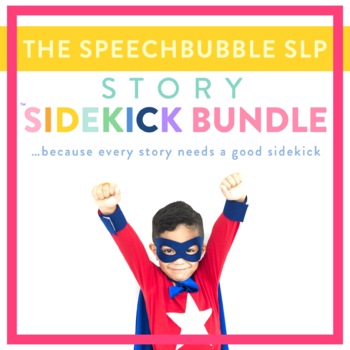
Story Sidekick Bundle
Language Rubrics
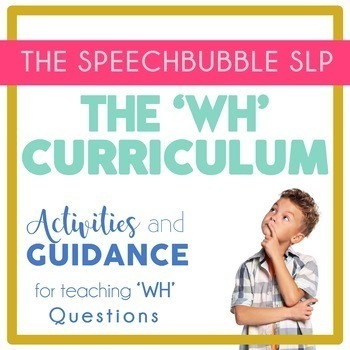
The 'WH' Curriculum Bundle
Share this post.

Meet Maureen
Hey there! I’m Maureen Wilson, a school-base SLP who is data driven and caffeine powered. My passion is supporting other pediatric SLPs by teaching them how to harness the power of literacy and data to help their students achieve their goals…without sacrificing time they don’t have.
- Organization

Get the basics you need to administer and analyze Dynamic Assessments in a school setting. Dynamic Assessments are great for:
- Assessing student’s language learning
- Assessing student’s with multi-lingual backgrounds
- Getting practical information to make confident decisions on eligibility and goals
Featured Products
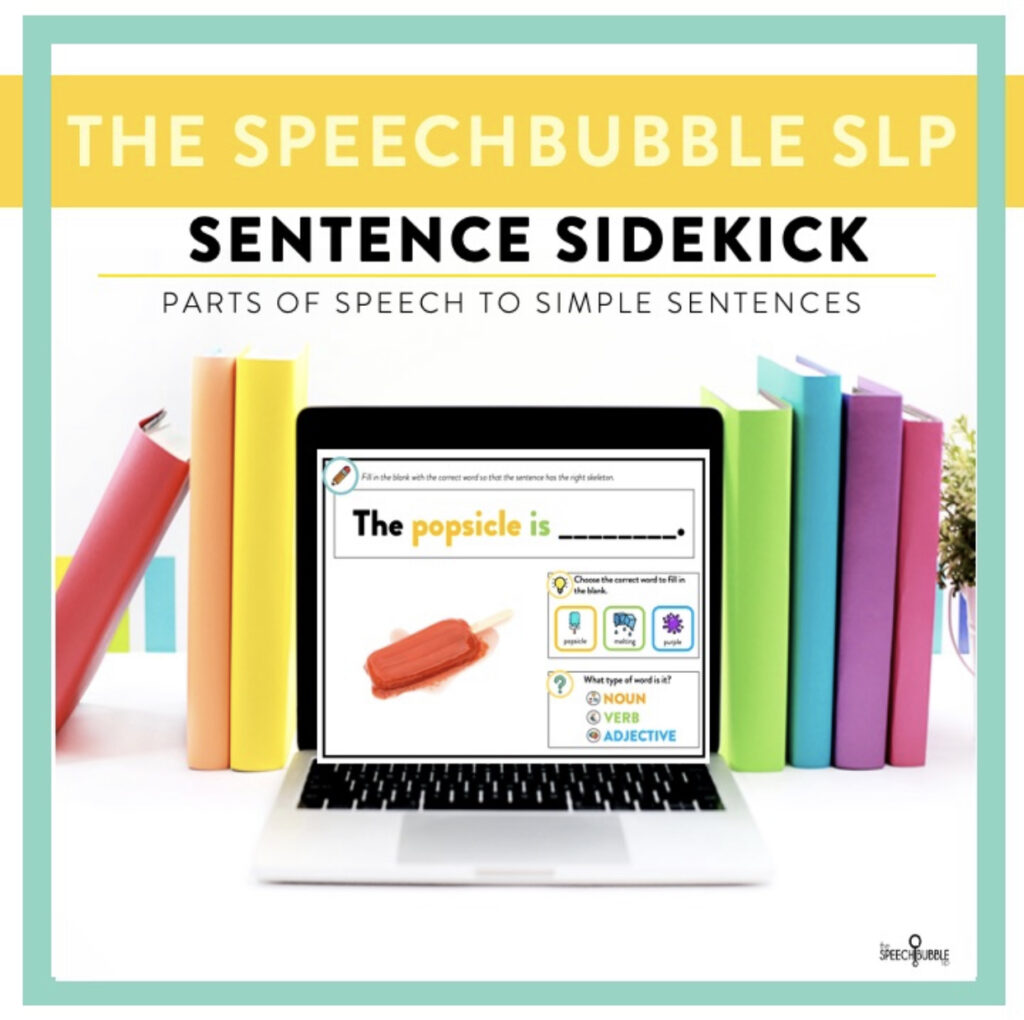
Sentence Sidekick Bundle
Language rubrics: a progress monitoring and data tracking tool, you might also enjoy....
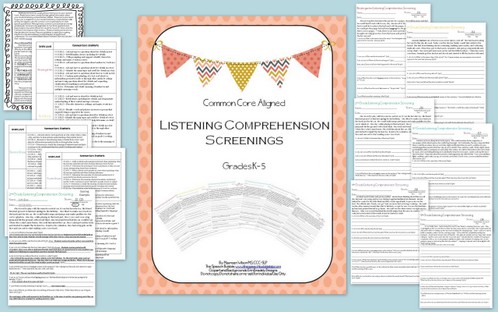
Listening Comprehension Screenings: Common Core Aligned
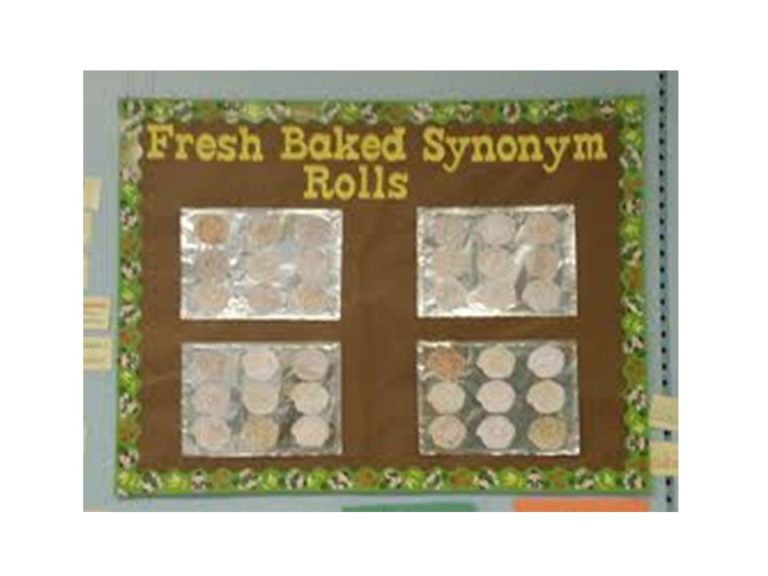
Synonym Rolls, Yum!

Speech Racer App Review
5 responses.
- Pingback: Tracking Vocabulary Data in Speech Therapy - The Speech Bubble
- Pingback: How to Stay Organised with Speech Therapy- The Speech Bubble
Awesome! Thank you so much for this information.
Thank you for sharing your expertise in this area. Your insights in this tiopic is very valuable and useful for SLPs like me who tries to squeeze out every precious minute out of their day for getting new ideas and ways of doing a well-used skill in fresh, new ways. The flashcards are certainly more than ready to retire, hahahahahaha!
- Pingback: Animal Island AILA Sit & Play Preschool Learning System Essential fo – Look Toys
Leave a Reply Cancel reply
Your email address will not be published. Required fields are marked *
Save my name, email, and website in this browser for the next time I comment.
Notify me of follow-up comments by email.
Notify me of new posts by email.
©2022 The Speech Bubble SLP. All Rights Reserved.
Designed by ashley hughes..

- Testimonials
- Gift Subscription
- Digital SLP Log In

Targeting Vocabulary Development in Speech Therapy Sessions
- April 5, 2021
Happy spring everyone! Today’s topic is all about vocabulary and how to target vocabulary in a variety of ways when treating clients via teletherapy. We will dive into how to work on vocabulary with clients of different age groups as well. I will be incorporating resources throughout this post targeting vocabulary development that also goes along with a spring theme so you can use them in your upcoming sessions!
Quick tip for targeting vocabulary development in speech therapy sessions :
When planning activities that target overall vocabulary development, try using thematic instruction within your speech therapy sessions! Integrating themes within speech therapy sessions helps to support improved vocabulary development along with additional receptive and expressive language skills. According to research, thematic instruction helps children learn basic concepts, categories, semantic mapping skills, word retrieval skills, answer wh-questions, and so much more (Maria Del Duca, 2013). All of these skills help support improved overall receptive and expressive vocabulary development.
When working with a student who is struggling with vocabulary development, try planning speech therapy sessions to go along with themes. You can even carry out the same theme over multiple speech therapy sessions to continue to provide repetition of familiar vocabulary words and concepts. Bring the theme to life through pretend play interactions, reading books, sensory play, movement-based activities, music, etc.
Using a thematic instruction approach, here are tips and resources for targeting vocabulary development with different age groups while using a springtime theme:
There are many different types of activities you can plan when working with young children on vocabulary development.
1. Targeting new vocabulary while engaging in play-based activities:
Whether you are conducting a speech therapy session in person or via teletherapy, try using toys and/or objects in these sessions when working on vocabulary development with younger students. Bringing in fun and interactive toys/objects within speech therapy sessions allows for increased engagement and more opportunities for vocabulary development.
Here are some examples of items you can use in sessions to work on vocabulary development with a spring theme:
- Easter Eggs: there are many different goals you can target while using Easter eggs in speech therapy sessions, all of which support vocabulary development. You can work on the child both receptively identifying colors as well as expressively labeling colors of eggs. Hide the eggs around the room and have the child find the various colors or tell you what color to find. You can also hide toys inside of the Easter eggs to go along with vocabulary development. Hide objects (or pictures of objects) that have associations with one another within the eggs (i.e. picture of sock in one egg and shoe in another – find the two pictures and put them together). You can even have the child guess what is inside each egg!
- Feed the Animal: young children love to play pretend with animals or dolls. One activity I love is “feed the frog”. You can find a frog puppet or… take a tissue box, put a picture of a frog on the box, cut out the frog’s mouth, and now you can “feed the frog!” You can talk all about frogs in your session, incorporate frog books, and then play your game where you feed the frog different silly “spring theme” pictures.
2. Using No Print resources to target vocabulary development in speech therapy:
There are many wonderful resources out there that you can incorporate into speech therapy sessions with younger children to target vocabulary development. Using fun and interactive no print resources can continue to encourage the development of language concepts along with vocabulary. I will share a few great resources from The Digital SLP site that go along with the spring theme.
Here are some examples from The Digital SLP website of resources you can use in sessions to work on vocabulary development with a spring theme:
- No Print Spring Actions Interactive Book Action Verbs : this resource targets expressive language to label the action within the picture shown. All of the pictures have a spring theme so you can talk to your students about the picture and relate them to your students’ personal experiences. Talk about puddle jumping, flying kites, or even feeding ducks! This resource also provides the opportunity to work on matching pictures.
- No Print Easter Vocab Builder : working on both receptive and expressive vocabulary development with young preschoolers, then this resource is for you! Talk all about Easter while learning new vocabulary terms. Not only are there sections to work on receptive vocabulary and expressive vocabulary, but you can also select “Learn About Easter” to read an interactive book with your students. If you are wanting to plan a vocabulary enriched session all about Easter, try using this resource and also bringing in the Easter egg idea from above!
- No Print Spring Vocab Builder : this resource is similar to the one listed above, but instead of only being about Easter it encompasses vocabulary pictures all about spring. There are many different concepts you can target using this resource and it is also a great choice when introducing the topic of spring.
Early Elementary:
There are several great resources and activities that target vocabulary development with children in early Elementary.
1. Targeting new vocabulary while engaging in activities:
as your students get a bit older, remember to continue to engage in hands-on and interactive activities along with incorporating resources in sessions. Help your students improve their vocabulary development by engaging in sensory activities, pretend-play, etc. Here are some examples of ideas you can use in sessions to work on vocabulary development with a spring theme:
- Sensory Activities: Creating sensory bins that relate to the spring theme can provide you with several opportunities to target vocabulary development. Try creating sensory bins with “grass” using green tissue paper or use beans to create “dirt”. You can cut out bugs to put in the grass/dirt and have the student describe the bugs. Or you can even cut out spring-related pictures and play a game of “I-Spy” to work on describing as well as labeling vocabulary words. Don’t worry – you can use sensory bins over teletherapy too! Create a bin and make sure your students are able to see the contents in your bin. You can still plan the same activities and the students will still remain engaged!
- Books: reading books in your sessions relating to spring allows for many opportunities to learn new vocabulary words. I especially love creating activities to go along with the books we read in order to enhance the new vocabulary terms we just learned in a more hands-on learning experience.
Here are some examples from The Digital SLP resources you can use in sessions to work on vocabulary development with a spring theme:
Language Packs and Interactive Spring-Themed Resources:
- Preschool Spring Language Pack : even though this resource says “preschool” in the title, this can be used both with preschool students as well as early elementary. This resource targets several receptive and expressive language skills, all supporting overall vocabulary development. Try working on pronouns and talking about all of the different spring-related actions. You can also try “Tell Me About It!” to work on hearing a description and labeling the spring-related object.
- Spring Elementary Language Pack : this resource is similar to the one listed above; however, it incorporates a bit more challenging skills to work on with your students. All of the activities are spring-related to continue to incorporate the spring theme in your session as your students are learning new vocabulary.
- Spring Pronouns Interactive Slides : use this resource to work on pronouns with your students while talking about the action verbs. Each picture depicts a different spring-related action (i.e. flying a kite, smelling flowers, blowing bubbles, etc.) allowing for continued opportunity for vocabulary development.
Later Elementary/Middle School/High School:
Web activity interactive slides spring reading passage.
Using a spring-related reading passage within your session may target reading comprehension skills, story retell, as well as vocabulary development. Have your students read the passage or listen to the passage, answering the questions as you go. Talk about the vocabulary terms in the story that your students may not know. Write out those vocabulary words so you can refer back. You can also relate these passages to the student’s personal experiences (i.e. Have they gardened before? What do they know about Earth Day?, etc.). Listed below are three different spring theme reading passages you can try with your students
- Gardening with Grandma
- St. Patrick’s Day
- Stretch-A-Sentence Language Expansion Activity : this resource may be modified for students both in middle and high school. Show the students pictures and have them describe what is happening in the picture. Prompt the student by asking “who”, “what”, “where”, “why”, and “when” questions in order to become more descriptive. These pictures allow for discussion using novel vocabulary terms to continue to work on improved vocabulary development.
I hope you have found these tips and resources helpful when targeting vocabulary development in speech therapy with students of all levels. Have fun planning your upcoming sessions all related to spring!
Kid Confidential: Using Thematic Instruction in Speech Therapy (Maria Del Duca, 2013).
ABOUT THE AUTHOR

Ready to give the Digital SLP ® a test drive?
Sign up for free today and join over 3,000 other SLPs.
Teletherapy platform-friendly activities and games for articulation, phonology, language, social skills, stuttering and more.

Recent Posts
- Five Videos to Use in Speech Therapy in September
- Five Videos to Use in Speech Therapy in August
- Five Videos to Use in Speech Therapy in July
- Creativity Tips for SLPs
- Five Videos to Use in Speech Therapy in June
Recent Comments
- SockLeng on How to Cope with a Chronic Illness while Working as an SLP
- Mskispeech on How to Cope with a Chronic Illness while Working as an SLP
- SockLeng on My Beautiful Stutter with Ryan Gielan
- Marcia Getfield on My Beautiful Stutter with Ryan Gielan
- SockLeng on 8 Tips for Teaching the R Sound
Related Posts
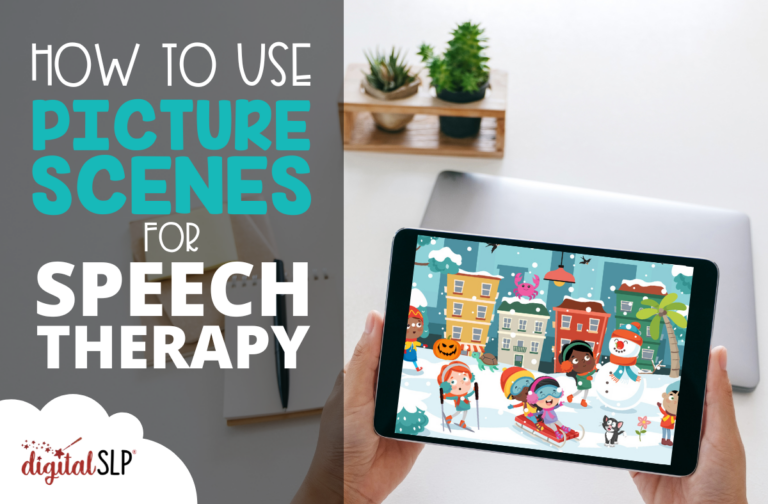
| membership! |
Did you know email subscribers receive exclusive discounts, helpful tips, and free resources? When you sign up for our newsletter you'll gain instant access to a library of digital freebies!
We treat your personal information with respect and would never sell it to another party.
Privacy Policy
- School Partnerships
- Join Our Team

Strategies for Vocabulary Intervention in Speech Therapy :
- December 23, 2022
- Literacy Skills , Reading Therapy , Speech Therapy
Semantic Mapping
Semantic mapping is a great strategy for vocabulary intervention. Semantic mapping can be a web, map, or graphic organizer of different words and/or pictures centered around one main idea. This allows a child to visually see how a word is related to other words and concepts. See example below:

Expanding Expressions Tool (EET)
The EET is a great way to increase your child’s vocabulary and language skills. The EET looks at one main word or object and allows you to discuss the object by talking about its group/category, what it does, what it looks like, its different parts, and where you find it. The EET is a multi-sensory approach and allows a child to clearly define and understand different vocabulary words and objects around them.
Context Clues
Context clues are hints or clues that can be found within sentences, passages, or even movies and videos. These hints and clues found allow your student to understand the meaning of new vocabulary. Context clues can appear as definitions, synonyms, antonyms, and through making inferences/conclusions.
Semantic Feature Analysis
Semantic feature analysis is a speech therapy technique and a form of verbal cueing to improve one’s ability to name and word find. For example, “white”, “drink”, and “liquid” are semantic features of the word “milk”. They would help an individual with a word finding or naming deficit.
- previous post: The Benefits Of Using a Wordless Picture Book
- next post: Employee Spotlight – Kaitlyn Kolano
Contact Us Today to Get Started
If you have been recommended for therapy, schedule an appointment today! If you’re uncertain if therapy is even an appropriate tool for your family, a free screening is a great place to start.
Subscribe to Our Newsletter
Our Mission: LLA Therapy’s mission is to set the standard for state of the art clinical and ethical therapy services in all venues serviced by our clinicians. Our work improves the lives of our clients and their families, supports the professional growth of clinicians, and creates a nurturing, supportive atmosphere. Offices include Fairlawn, Hudson, Medina, and Mentor Ohio.
Copyright LLA Therapy 2024 - All Rights Reserved
- Speech-Language Therapy
- Physical Therapy
- Occupational Therapy
- ABA Therapy
- Reading Therapy
- Online Therapy
- Summer Programs
- Appointment Prep & Forms
- What to Expect
- Office & Financial Policies
- Scholarship Information
- Find a Location
- Schedule an Appointment
LLA Therapy
Crystal scheibe, karrie swan larock, heather dougherty-pantoja, terri apgar, kelli geisler davisson, victoria hansford-price, laura lee hogsett, amy furukawa, jessica havalotti.
An official website of the United States government
The .gov means it’s official. Federal government websites often end in .gov or .mil. Before sharing sensitive information, make sure you’re on a federal government site.
The site is secure. The https:// ensures that you are connecting to the official website and that any information you provide is encrypted and transmitted securely.
- Publications
- Account settings
Preview improvements coming to the PMC website in October 2024. Learn More or Try it out now .
- Advanced Search
- Journal List
- Wiley Open Access Collection

The final chapter of Vygotsky's Thinking and Speech : A reader's guide
René van der veer.
1 Department of Education, Leiden University, Leiden, 2311, The Netherlands
2 School of Psychology, University of Magallanes, Punta Arenas, 01855, Chile
Ekaterina Zavershneva
3 Department of Psychology, Moscow University of Medicine and Dentistry, Moscow, 127473, Russia
The seventh and last chapter of Vygotsky's Thinking and Speech (1934) is generally considered as his final word in psychology. It is a long chapter with a complex argumentative structure in which Vygotsky gives his view on the relationship between thinking and speech. Vygotsky's biographers have stated that the chapter was dictated in the final months of Vygotsky's life when his health was rapidly deteriorating. Although the chapter is famous, its structure has never been analyzed in any detail. In the present article we reveal its rhetorical structure and show how Vygotsky drew on many hitherto unrevealed sources to convince the reader of his viewpoint.
1. INTRODUCTION
Lev Vygotsky (1896–1934) was a Soviet psychologist who worked in the 1920s and early 1930s. He taught at various universities and higher institutes, worked with special‐needs children, published monographs and textbooks, and became a prominent figure in the Russian variant of pedology, the discipline of child studies. His fundamental claim was that human beings differ from other animals in that they acquire cultural means that radically restructure their behavior and cerebral organization. The most fundamental cultural means is language (speech in Vygotsky's terminology), which makes it possible to transcend the here and now and to solve problems on a theoretical plane. Because language and cultural tools differ per culture Vygotsky believed it possible to find cross‐cultural differences in intellectual development. More in general, he believed that instruction propels intellectual development into directions that would not be possible otherwise.
Vygotsky's ideas generated much research but shortly after his death this line of research came to a rather abrupt stop. The Soviet government issued a decree banning the discipline of pedology with which Vygotsky was intimately connected. Pedology fell into disrepute because it was associated with the massive use of intelligence tests as a means for selection for schools without taking the social background of the children into account. As a result, Vygotsky's writings were no longer available and it would last until the 1950s before his students managed to lift the ban. It would take until 1962 before Vygotsky was published in the West, where he remained totally unknown. In that year an abridged English version of his last book, Thinking and Speech (Vygotsky, 1934a ), was published under the title of Language and Thought . Vygotsky's book struck a chord, perhaps because it seemed to provide an alternative to Piaget's more individualistic and maturational view of children's intellectual development, and further translations of his writings would follow. Today, Vygotsky's ideas are generally known, he counts as one of the better known psychologists of the twentieth century (Haggbloom et al., 2002 ), and a growing group of researchers is trying to test and extends his ideas.
Thinking and speech (Vygotsky, 1934a ) remains arguably Vygotsky's most famous book. It was translated into many languages (e.g., Vygotsky, 1962 , 1986 , 1987 , 1990 , 2001 , 2002 , 2003 ), has been cited thousands of times, and is generally considered to be Vygotsky's major contribution to psychology, which represented the views he held in the very last part of his life. However, this view has not gone uncontested. Elsewhere we have argued that Thinking and Speech , although finalized shortly before or after Vygotsky's death, did not represent his latest views and that Vygotsky himself considered the book an intermediate result of a longer unfinished project (Yasnitsky & Van der Veer, 2016 ; Zavershneva & Van der Veer, 2017 ). Others (e.g., Lompscher & Rückriem, 2002 ) have discussed the authenticity of the book given the fact that it was published roughly half a year after Vygotsky's death and censorship was common practice in the Soviet Union at the time. Finally, it has been pointed out that Thinking and Speech was not a coherent whole or monograph. Rather, it was a collection of loosely connected articles and chapters published between 1929 and 1932 plus several parts written or dictated for the occasion, notably the first and the final chapter of the book (Van der Veer & Yasnitsky, 2011 ). In sum, the last word has not yet been said about both the value of Thinking and Speech and the history of its writing.
It is the final chapter that has drawn most attention from researchers. In that chapter Vygotsky sketched the nature of inner speech and its relation with overt speech, on the one hand, and thought, on the other hand. Because inner speech is not observable, Vygotsky tried to infer its properties by extrapolating from other, observable, speech forms. Thus, he argued that, developmentally speaking, egocentric speech is inner speech's precursor and that inner speech has certain properties in common with variants of dialogic speech. In his complex argumentation, Vygotsky relied partly on data obtained in his own empirical research and partly on phenomena described by other researchers, notably contemporary linguists. It is in the description of the linguistic phenomena that Vygotsky's text, on closer inspection, becomes very peculiar: substantial parts of his text appear not to have been written by himself. Rather than Vygotsky's text, they are verbatim quotes from the work of colleagues. In the continuation, we shall closely follow Vygotsky's argumentation, highlight the many hidden quotes, give their original sources, and, finally, speculate about the reasons for such a construction of the chapter's content and raise the question as to its authorship.
2. VYGOTSKY'S ARGUMENTATION 1
Vygotsky began his argumentation by stating that previous researchers did not understand the true nature of verbal thought. They did not see that word meaning develops over time and that thus one and the same word may refer to different aspects of reality. The adult's concept of “father,” for example, differs substantially from the child's concept of “father.” Vygotsky added that the transition from thought to word and back again is actually a very complex process with various stages. It is not true, for example, that thought is simply expressed in words. Here Vygotsky ( 1987 , pp. 250/251/28) several times used an expression borrowed from Potebnya “The thought is not expressed but completed in the word.” 2 Actually, in speech we need to distinguish its inner, semantic side and its external, audible, or phasic side, which have their own dynamics. To illustrate that distinction, Vygotsky gave two examples from the development of children's speech: first, child speech goes from one‐word sentences to more complex, differentiated sentences; second, these first one‐word sentences mean many things and only gradually acquire a specific meaning. Thus, the semantic and phasic sides go in opposite directions and need to be distinguished even though they are intimately related. For those who did not find this convincing enough, Vygotsky adduced other evidence from the development of children's speech: the fact, demonstrated by Piaget, that children can use conjunctions like “because” and “although” before they actually understand them: in the development of speech grammar seems to precede logic and syntax seems to precede semantics. 3 In other words, the semantic and phasic developments of speech diverge. But this is not all, Vygotsky argued; in adult speech as well we can distinguish the semantic and the phasic plane. It was here that Vygotsky for the first time referred to linguistic sources and it is here that we can identify the first unidentified quotes. On the pages 251–252, Vygotsky wrote that we cannot rely on grammar to understand the meaning of utterances:
Fasler argues that it is wrong… and “severe spectacle” the predicate. 4 (7 lines)
This passage was, in fact, quoted from Vossler's ( 1923 ) study of grammatical and psychological speech forms. Vygotsky then further explained the fact that the grammatical and the psychological subject do not always coincide with the example of “the clock fell.” The interpretation (and intonation) of that sentence is dependent on the subject's situation. In arguing that grammatical and psychological categories are different, Vygotsky (p. 252) further referred to Paul's ( 1891 ) book on the history of language in which it was argued that grammatical categories have their psychological counterparts.
According to Paul, the grammatical category… its semantic structure. 5 (3 lines)
In elaborating that theme he then extensively quoted Vossler ( 1923 ) again. In fact, the following passage on p. 252 was entirely based on Vossler.
Thus, correspondence between the grammatical and psychological structure… pronouns, superlatives, and tenses. 6 (10 lines)
Vygotsky continued with the remark that grammatical mistakes may have artistic value and quoted a poem by Pushkin. Remarkably, this literary quote was immediately followed on pp. 252–253 by another quote from Vossler ( 1923 ), which again so far went unnoticed. Vossler remarked that unambiguous expressions are only possible in mathematics.
Only in mathematics do we find… movement that we call evolution. 7 (8 lines)
Vygotsky explained that he gave his examples to show that the external, phasic side of speech and the semantic side may diverge, but that they are nevertheless fundamentally connected. To show this connection, he then provided two examples where the formal, grammatical structure dictated meaning or the other way around. The first example was Krylov's fable “The dragonfly and the ant,” based on a fable by La Fontaine. Krylov replaced La Fontaine's grasshopper by a dragonfly to retain the image of female frivolity, which led to a strangely hopping dragonfly. Vygotsky's second example was that of Heine's poem “Der Fichtenbaum” and the translations into Russian by Tyutchev and Lermontov. In German the two trees have a different gender, which confronts the Russian translator with a problem. A literal translation (Lermontov) loses the gender difference, which may be preserved by replacing one of Heine's trees by another one with the right gender (Tyutchev). This example, which Vygotsky discussed on p. 253, nicely demonstrated how grammatical properties of words, such as their gender, may suggest certain meanings. However, the example was not original with Vygotsky. In fact, the entire discussion was based on a famous talk given by the linguist Shcherba in 1926, who discussed the different Russian translations of Heine's poems in some detail. 8 For Vygotsky, these examples demonstrated that one may distinguish a grammatical and a semantic plane of speech and that the relationship between these planes is flexible. Moreover, he claimed that children have to learn the distinction, that is, they have to learn that the relationship between words and the concepts or objects they designate is conventional. Young children tend to regard words as a property of things and find it very hard to refer to things with other, invented, words. In other words, for young children words are tied to the object and have a nominative and indicative function. Meaning, independent of object relatedness, and signification, independent of the pointing to and naming the object, develops later according to the lines sketched above. Vygotsky added that this development is accompanied by another development: The syntax of thought must be transformed into the syntax of words. Thought determines the logical emphasis, which creates the psychological subject. Speaking requires the transition from the internal to the external plane, understanding the opposite. This was a rather dense passage that seemed an insert and became clarified only much later in the chapter.
Vygotsky now first switched to the topic of inner speech or endophasia and its various interpretations by the experts. In this context he mentioned Schilling ( 1929 ) and on p. 256 he literally quoted his distinction between inner speech and inner speaking, a fact that again went unnoticed by the readers of Vygotsky's chapter:
Recently, Shilling has proposed… hinder the thinking function. 9 (11 lines)
Vygotsky's (p. 256) reference to Goldstein's view of inner speech also seems to be based on Schilling ( 1929 ). 10 The weak point of the existing views on inner speech was, according to Vygotsky, that they did not understand its specific function and gave no explanation of its origin. It is here that Vygotsky switched to a lengthy discussion of his experiments with the registration of egocentric speech, which at the same time was an elaborate critique of Piaget's view on egocentrism. This part, which runs from p. 257 to approximately p. 266, was the core of Vygotsky's argumentation and also the part that reads most fluently and, naturally, is the least reliant on other sources.
Vygotsky's fundamental idea was that egocentric speech was a precursor of inner speech and can be used to infer its properties. This was an idea that was foreign to Piaget and Vygotsky first explained what he saw as the core of Piaget's view. According to Piaget, Vygotsky argued, egocentric speech reflects the child's original autism, which only gradually gives way to social thought under the pressure of the environment. It is incomprehensible and abbreviated, because it has not yet been fully socialized and has no function whatsoever in children's behavior. Under the consistent pressure of social others egocentric speech will just fade away. Vygotsky's own view was that egocentric speech was yet another example demonstrating the sociogenetic law, which stated that individual functioning originates in social, collective functioning. 11 Egocentric speech is speech that splits off from speech for others and serves intellectual orientation. This is why egocentric speech increases when children meet with difficulties. Vygotsky also claimed that egocentric speech becomes more incomprehensible when children grow older, but here we have to believe him on his word, because he adduced no evidence. To decide who was right about the function and fate of egocentric speech, Vygotsky decided to carry out a number of experiments. His reasoning was that in Piaget's view weakening the child's social situation must lead to more egocentric speech, because there is less social pressure on the child to adapt his or her autistic thinking to social demands. In Vygotsky's own view, weakening the social situation would lead to less egocentric speech, because the child no longer has the illusion that he or she is being heard. Children believe they are understood; their egocentric speech is social. In this connection, Vygotsky said (pp. 263–264) that Grünbaum ( 1927 ) reached the same conclusion. Again, it was not noticed that a substantial part of p. 264 was a direct quotation from Grünbaum's article.
[Grunbaum argues that] superficial observation… are the common property of all. 12 (18 lines)
Vygotsky then discussed the experiments in which he and his associates placed a child (1) among deaf‐mute or foreign children; (2) among children unknown to the child or at a separate table, etc.; and (3) far away from other children, in noisy conditions, or with the instruction not to speak aloud but to whisper. In all conditions egocentric speech diminished as compared to a baseline condition. Unfortunately, Vygotsky provided no absolute numbers, just proportions (e.g., egocentric speech dropped 6:1), and mentioned no other details (e.g., number of subjects, age of subjects; definition of egocentric speech), so that it is somewhat difficult to understand and replicate his research. Piaget ( 1959 ), in the third edition of his The language and thought of the child , would later dismiss such experiments as irrelevant, because what he had in mind was intellectual egocentrism, that is, the inability to take the viewpoint of others. In his view, Vygotsky was indeed right that children want to be heard and address others, but the whole point is that young children do not realize that the others do not understand them, because these others do not have the same information.
Be that as it may, Vygotsky believed he had refuted Piaget's claim that egocentric speech has nothing to do with social speech. Egocentrism does not fade away under social pressure, Vygotsky claimed; it just becomes transformed into inner speech and goes underground. And if that is true, then the properties of inner speech may be inferred from the properties of egocentric speech. Rather surprisingly, at this stage of his argument, Vygotsky did not discuss these properties. Later on in the chapter, he stated that egocentric speech becomes less comprehensible when children grow older, but this was again a claim for which he provided no evidence. So, rather than beginning with a discussion of the properties of egocentric speech and extrapolating these to inner speech, Vygotsky assumed certain properties of inner speech on other grounds. Here (p. 267) he quoted Watson's statement that recorded inner speech would still be incomprehensible:
Even if we could record these hidden… but individual adaptation. 13 (5 lines)
We now arrive at one of the most peculiar parts of Vygotsky's chapter. Vygotsky believed that inner speech is abbreviated and predicative and to argue that viewpoint he pointed out the same phenomena in normal, overt speech. The peculiar thing is, however, that all the examples he adduced and the reasoning behind it on pp. 267–274 were entirely based on Yakubinsky's ( 1923/1986 ) well‐known essay on dialogic speech. For example, when Vygotsky on p. 267 explained that in a dialogue our reply can be very brief and gave examples:
First, no one would answer… he read it. 14 (7 lines)
he was repeating Yakubinsky. And when on the next page (p. 268) Vygotsky provided examples of abbreviation from literary sources, he was again speaking through Yakubinsky. For instance, the introductory sentence
We find many examples… psychology of understanding. 15 (3 lines)
and the example of the conversation between Kitty and Lewin plus the statement that it was inspired by an episode in Tolstoy's own life (41 lines in total) were all borrowed from Yakubinsky, who, however, did not present Tolstoy's text given that it was “widely known.” On the next pages Vygotsky continued paraphrasing and citing Yakubinsky, which was sometimes immediately evident, because he used words like “verbal stimuli,” “discursive speech,” and “apperceptive mass” that did not fit the context. A short and a long quotation can be found on p. 269:
When the thoughts… reduced to a minimum. 16 (3 lines)
Levin had grown used… of more discursive speech. 17 (15 lines)
Vygotsky concluded that under certain circumstances even in overt speech such phenomena as abbreviation, simplified syntax, and a tendency toward predicativity can be found. He then continued on p. 269 with a comical example of complete nonunderstanding between deaf people—taken from a poem by Pushkin—that seemed the opposite of the easy comprehension in the conversation between Kitty and Levin. Again, this example was inspired by Yakubinsky.
Before the deaf judge two deaf men bow… the girl's to blame. 18 (6 lines)
Vygotsky's next remark on p. 269 about Tolstoy was also borrowed from the same source.
As Tolstoy says… the thought of others. 19 (2 lines)
Like Yakubinsky, Vygotsky now introduced the topic of written speech to clarify the extremes of, one the one hand, abbreviation in dialogic speech and elaboration in written speech, on the other. In written speech we need to be much more elaborate, because we cannot take joint knowledge for granted. In other words:
[Polivanov has noted that] if we included all … thoughts than we do. 20 (3 lines)
But this is exactly the case of written speech, Vygotsky said. It is speech without an interlocutor, so it requires maximal explicitness. Here, on p. 270, Vygotsky quoted a certain Thompson, but again via Yakubinsky.
As Thompson has pointed out… seem artificial in oral speech. 21 (2 lines)
Vygotsky continued his reasoning by stating that linguists had recently advanced the notion of the heterogeneity of speech forms. Like Yakubinsky, he noted that Von Humboldt and Potebnya had distinguished prose and poetry, which have their own lexicon, grammar, and syntax, but had not developed this idea any further. 22 Vygotsky (p. 270) then quoted Yakubinsky as saying:
The very statement of this problem… on general linguistics. 23 (3 lines)
Vygotsky then returned to the topic of dialogic speech and stated that dialogue always presupposes visibility of the interlocutor and his gestures, the hearing of his intonation, etc. 24 He then (p. 271) seemed to quote Tarde on the properties of conversation, but again this was an indirect quotation via Yakubinsky.
Only in oral speech do we find… between the interlocutors. 25 (2 lines)
To illustrate the role of intonation in the comprehension of speech Vygotsky (p. 271) gave yet another literary example. Both the introductory sentence and the example from Dostoevsky's Diary of a writer , that is, almost the entire page 271, were borrowed from Yakubinsky:
Dostoevskii's writings provide us… I was a witness. 26 (32 lines)
On the basis of this somewhat far‐fetched example, Vygotsky concluded that abbreviation can occur when there is mutual comprehension (e.g., the persons refer to the same topic or object) or when the meaning is communicated through intonation. In fact, this is what makes dialogue easier and more natural than monologue or written speech. Here Vygotsky (p. 272) referred to Shcherba's remark about the artificial nature of monologic speech, but was again citing Yakubinsky:
He [Shcherba] argues that monologue is… in dialogue. 27 (2 lines)
Vygotsky (p. 272) added that Yakubinsky had expressed the same idea.
Yakubinskii expresses this idea… than monologue. 28 (3 lines)
In his attempt to further differentiate monological from dialogical speech, Vygotsky again heavily relied on Yakubinsky and quoted him repeatedly. See, for example, on p. 272:
The rapid tempo of oral speech is not conducive… immediate expression. 29 (6 lines)
And on the same page:
The potential for incomplete expression… that appear in consciousness. 30 (8 lines)
And on p. 272 again:
Understanding must be produced… rough draft in thought. 31 (6 lines)
Having established the phenomena of abbreviation and predicativity in certain forms of overt speech, Vygotsky now turned to inner speech again. It was his fundamental belief that, because in inner speech speaker and interlocutor coincide, abbreviation and predicativity should be even more outspoken. The subject of a phrase is always omitted, because it is known beforehand and needs not to be mentioned. To understand ourselves we need very little information; we can sometimes even guess a sentence spoken by others on the basis of the initial letters of the words. Here Vygotsky (p. 275) stated that he found a remarkable analogy in Lemaitre's ( 1904 ) article on the inner speech of children. Lemaitre had asked children how they experienced their inner speech, whether they believed they heard or saw it, and one boy told him that he visualized the phrase “Les montagnes de la Suisse sont belles” (The mountains of Switzerland are beautiful) as a series of letters “LmdlSsb” with a vague mountain landscape above it. 32
To Vygotsky, Lemaitre's example and the phenomena of abbreviation and predicativity he had discussed earlier proved that in inner speech meaning is more important than syntax. Or, put in the terms he used at the beginning of his chapter, in inner speech the phasic side is reduced and the semantic side takes precedence. But in Vygotsky's view there was more: he also claimed that in inner speech sense dominates over meaning. To clarify this distinction, he referred on p. 275 to Paulhan ( 1928 ) and, in fact, it is not exaggerated to say that the next three to four pages of his chapter were fully based on Paulhan.
A word's sense is the aggregate… as a result of the word. 33 (3 lines)
Paulhan described the signification of a word as a set of concentric circles of which the most inner zone corresponded with the most stable, dictionary meaning of the word and the outer zones represented the word's sense or connotation. Sense, in Paulhan's view, was determined by the context of the word. As Vygotsky (p. 276) explained:
Paulhan states that the word's sense… in varied circumstances. 34 (3 lines)
Paulhan went even further and claimed that the sense of a word can only be judged in the context of the book, which in its turn can only be judged against the background of the author's other books, etc. This argument Vygotsky quoted on p. 276 and he also used it in his discussion of the title of Gogol's Dead souls , which has acquired another meaning when the novel is finished.
According to Paulhan… its sense is never complete. 35 (5 lines)
In Vygotsky's opinion one of Paulhan's greatest merits was that he distinguished sense and meaning and showed that words may also lose their meaning in phrases such as “How do you do?,” when no answer is expected. In a way, then, meaning and sense may be separated. Again Vygotsky (pp. 276–277) quoted Paulhan to illustrate this fact:
He argues that in the same way… phrase as a whole. 36 (3 lines)
However, the word cannot exist without sense nor can sense exist without the word. 37
Here Vygotsky ended his discussion of Paulhan ( 1928 ) with the claim that sense dominates over meaning in inner speech. In fact, in his view the prevalence of sense was characteristic of inner speech; it was its fundamental feature.
Another feature of inner speech, Vygotsky continued, was the merging of words. Again, he turned (p. 277) to overt speech for examples of this phenomenon of agglutination and found one in Wundt.
In German, the single noun… and conjugated in the same way. 38 (20 lines)
Once again Vygotsky claimed that he had seen similar phenomena in egocentric speech and once again we have to trust him on his word. Supposedly, agglutination in egocentric speech increased as the child grew older. And again, Vygotsky posited that agglutination was even more prevalent in inner speech. In inner speech sense dominates over meaning; a single word can capture a whole gamma of meanings. It is these semantic properties of egocentric and inner speech that make it incomprehensible without additional information and Vygotsky felt that he was the first to provide a satisfactory explanation for this fact. To further clarify the incomprehensibility of egocentric and inner speech, he mentioned just two more aspects. First, functionally, inner speech is not meant for communication and thus does not need to be understandable. Second, when we share an environment we often develop a joint language, a jargon, or a dialect. 39 Once more, Vygotsky extrapolated this finding to inner speech. Experiments had shown, he said (p. 279), that word meanings in inner speech are always untranslatable idioms, full of idiomatic expressions, ellipsis, etc. In inner speech one word is enough, but it has another meaning than in overt speech.
Here Vygotsky stopped his overview of the properties of inner speech. He once again claimed he had first observed the phenomena in egocentric speech and subsequently compared them with similar phenomena in overt speech. His conclusion was that inner speech derives from overt speech through egocentric speech, which confirmed his original hypothesis. However, in itself inner speech is a transitional form between word and thought. To understand it, Vygotsky argued, we must probe still deeper and study thought itself. Each thought moves, unfolds, strives to establish something, but the units of thought do not coincide with the units of speech. We all know the phenomenon that we cannot find the words to convey an idea. Again, Vygotsky turned to a literary example, this time from a story by Gleb Uspensky about a petitioner who cannot find the words to express his ideas, and quoted it at some length. 40 The example showed that thoughts do not directly coincide with words and Vygotsky added that actors had known it all along. To further explain this issue, Vygotsky turned to yet another literary example, Griboedov's comedy Woe from wit , as analyzed by the stage director Stanislavsky. In Stanislavsky's work we find the attempt to uncover the subtext, the thoughts and feelings behind the spoken words and Vygotsky focused on Stanislavsky's analysis of the conversation between Chatskiy and Sof'ya. 41 Stanislavsky clearly showed that one and the same idea may be expressed in various ways and that one and the same expression can mean various ideas. Thoughts do not coincide with words; a speaker can develop an idea during several minutes. Here Vygotsky introduced an image that has become well known: A thought can be compared to a cloud that gushes a shower of words. That it is difficult to convey ideas by words had been understood by many. The transition is complex and led to the well‐known complaints by the poets Tyutchev (How can a heart expression find?) and Fet (If only the soul could say things without words) and the poet Khlebnikov's neologisms. 42 But words cannot be avoided, one consciousness cannot communicate with another consciousness directly, mediation through meanings and words is always inevitable.
It was here that Vygotsky arrived at the final step in his argumentation; the step behind thought. Thoughts are caused by emotions, needs, and drives. Or in Vygotsky's image: we need the wind that causes the cloud of meaning to gush its shower of words. Ultimate understanding of utterances requires knowing their motivational undercurrent. Rather surprisingly, Vygotsky turned again to Stanislavsky's analysis of Woe from wit to show that every utterance hides a motive and again (pp. 282–283) quoted his analysis extensively. His conclusion was that in order to understand an utterance we indeed need to understand the speaker's motive.
Here Vygotsky rounded up his argumentation. He concluded that he had shown that the relationship between word and thought is not stable but dynamic: it changes over time. The trajectories from word to thought and from thought to word go through many intermediate stages and involve complex transformations. To understand this complex phenomenon a historical approach was needed and then it could be seen that words without meaning are dead. Here (p. 284) Vygotsky quoted the poets Mandel'shtam and Gumilyev:
As the poet says: “Like bees in a deserted hive, dead words reek.” But as another poet says, the thought that is not embodied in the word will remain a Stygian shadow, “mist, chimes, and void.” 43
Hence, the connection between thought and word is not primordial and fixed, it is always developing. Vygotsky now quoted Goethe's attempt in Faust to dethrone the word (in the beginning was the deed) and replied with Gutzmann that we can choose a different intonation and say “in the beginning was the deed.” The word is the end that crowns the deed.
we can agree with Goethe… in the beginning was the deed. 44 (5 lines)
This was the end of Vygotsky's study of word and thought, but on the final page of his chapter he hinted that it was only the beginning of the study of an even bigger problem: the problem of consciousness. Words reflect reality in another way than feelings. But if consciousness can reflect reality in various ways that means that there are various types of consciousness. Speech and thinking form the key to the comprehension of consciousness. And, of course, quite characteristically, Vygotsky ended his chapter on p. 285 with several quotes
If “language is as ancient as consciousness itself,” if “language is practical consciousness that exists also for other men, and for that reason for me personally as well,” if “from the start the pure spirit is afflicted by the curse of matter, the curse of moving layers of air.” 45
[The word is] what—in Feuerbach's words—is absolutely impossible for one person but possible for two. 46
and the famous image “Consciousness is reflected in the word as the sun in a droplet of water… The meaningful word is a micro‐cosmos of human consciousness.” 47
3. A POSSIBLE EXPLANATION
Above we have presented Vygotsky's arguments in the final chapter of Thinking and speech in some detail. Our goal was not so much to criticize his line of reasoning—although we made some critical remarks—but to lay bare several of the unidentified sources on which he drew. It turned out that Vygotsky's chapter was a veritable patchwork of unidentified quotations and that large parts of his text have to be attributed to other authors. Although Vygotsky often relied on other authors and tended to refer to them in a somewhat vague manner (e.g., “a well‐known author once said”), we know of no other Vygotskian text where it was this extreme. 48 This brings us to the question: how on earth could this happen?
To understand this somewhat better it is useful to have another look at the novelty of Vygotsky's reasoning in chapter 7. Was what Vygotsky supposedly dictated in the final month of his life representative of his newest ideas or was he rehearsing insights from previous years? To begin with, we can have a look at his argument that egocentric speech splits off from social speech, acquires an intellectual function, and gets transformed into inner speech. We then see that Vygotsky discussed this topic in various articles, presentations, and chapters in the period 1928–1931 (e.g., Vygotsky, 1928 , 1928/1935 , 1929 , 1930b , 1931a , 1931b ). Well known is, for example, that Vygotsky's closest collaborator, Aleksandr Luria, presented their ideas about egocentric and inner speech at the Ninth International Congress of Psychology in New Haven in 1929 (Vygotsky & Luria, 1930 ). Thus, we may conclude that this central part of Vygotsky's whole argumentation in the final chapter of Thinking and speech was not novel at all and had formed part of his thinking since at least 1929. Or, in other words, what was Vygotsky in chapter 7 was not new. Because Vygotsky in chapter 7 for the first time presented a whole set of findings by linguists to convince the reader of his viewpoint that inner speech has specific properties, we might also conclude that what was new in chapter 7 was not Vygotsky. However, this would be only true to a degree. It was indeed true that the new ideas were borrowed from other thinkers and that Vygotsky presented these linguistic arguments for the first time to the general reader. However, these linguistic ideas had formed part of his thinking since at least 1932 and he had shared them at informal gatherings with his group of co‐workers. That this is so becomes apparent from his notebooks (Zavershneva & Van der Veer, 2017 ) and from a published internal talk (Vygotsky, 1997 ). Thus, when we take a look at the notebooks written in the second half of 1932 (cf. chapters 15–18 in Zavershneva & Van der Veer, 2017 ), we see that all of the references to literary (e.g., Fet, Dostoevsky, Griboedov, Gumilyev, Mandel'shtam, Stanislavsky, Tolstoy, Tyutchev, Uspensky) and linguistic (e.g., Paulhan, Potebnya, Vossler, Yakubinsky) sources are already present. The same is true for the conceptual distinctions (e.g., sense vs. meaning, phasic vs. semic speech, written vs. oral and inner speech), the alleged properties of inner speech (agglutination, abbreviation, dominance of sense over meaning, idiomatic nature, predicativity), the examples (“the clock fell,” the dialogues between Sof'ya and Chatskiy, and Kitty and Levin), and images (e.g., the cloud of thought that gushes a shower of words) that Vygotsky provided in chapter 7. Moreover, in Vygotsky ( 1987 , pp. 132–135) we can find an account of an informal talk that Vygotsky gave on December 5, 1932, which presented all of these aspects in more or less the same way as they would be printed almost two years later in the final chapter of Thinking and speech . In other words, even the linguistic arguments presented in this chapter were already known to his group of associates since at least 1932. This means that Thinking and speech consisted of a collection of older papers and chapters plus several new chapters that were based on older material.
Now that we know that all the material published in the final chapter of Thinking and speech represented ideas from 1932 and earlier, we must still wonder why this material was prepared for publication in the spring of 1934. We know that Vygotsky had been planning to publish such a book for a number of years and that his book proposal was criticized on several occasions. Vygodskaya and Lifanova ( 1996 , pp. 136–137) mention such a discussion at the Leningrad institute of Education on April 2, 1932, and Zavershneva and Van der Veer ( 2017 , chapter 19) provide Vygotsky's account of a similar meeting that took place at the Psychological Institute in Moscow in the fall of 1932. Vygotsky had to present his proposal to the members of the Party Cell of the Institute and subsequently the members voiced their criticism. Basically, the members felt that this was “not Marxist psychology,” that one “didn't feel dialectical materialism,” and that the “social class aspect” was lacking. It is quite possible, then, that Vygotsky decided to delay the publication plans for Thinking and speech until better times. But why, then, did he decide to give it another try in the spring of 1934? To understand this we must take a broader look at the situation in the academic world in Russia at that time.
On January 13, 1934, the Council of the People's Commissars of the SSSR (i.e., the government of the Soviet Union) issued a decree about scientific degrees and titles. Essentially, the decree introduced the system of two dissertations: the candidate's and the doctoral dissertation. More importantly, the decree stipulated that in certain cases the obligation to defend the dissertation could be waived (Kozlova, 2001 ). What is even more, the decree added that in some cases a dissertation was not even necessary, but that one or more already published books (or discoveries or inventions) would suffice to get the necessary degree. Such exemptions were especially meant for persons who were already working as a university professor and had shown their merits in academia (Kozlova, 2001 , p. 155). The universities were quick to realize the possibilities of this decree and in the period from 1933 to 1940 the possibility to confer degrees to persons who had not written a dissertation was widely used. In fact, when a certain position required a doctoral degree this was arranged quickly, also because it was not clear how long the possibility of exemptions would last. In psychology, people like B.G. Anan'ev (degree conferred in 1937), N.A. Bernshteyn (1935), P.P. Blonsky (1935), K.N. Kornilov (1935), and S.L. Rubinshteyn (1937) received their candidate or doctoral degree without having submitted or defended a dissertation. All of them submitted in 1934 or 1935 one or more books they had recently edited or written to get the required degree. It is quite conceivable that Vygotsky as well, who already was a professor and who had in January 1934 accepted the invitation to become head of the psychological section of the All‐Union Institute of Experimental Medicine, decided to use this temporary relaxation of the rules to get the degree that corresponded with his functions and status. That hypothesis would explain why Vygotsky, who had not published books in 1932 and 1933, just like his colleagues urgently needed one or more new books to comply with the requirements. Hence, Thinking and speech (Vygotsky, 1934a ), and possibly one or more of the other posthumously published volumes may have been originally prepared for that occasion. These were Foundations of pedology (Vygotsky, 1934b ) and Children's cognitive development in the process of instruction (Vygotsky, 1935 ), both collections of university lectures, and the edited volume The mentally retarded child (with Vygotsky & Danyushevskiy, 1935 ).
However, although the decree may explain why Vygotsky quickly needed one or more books and decided to publish a collection of older material, we still have no satisfactory explanation for the disturbing number of unidentified citations. Here, again, we can only offer a tentative explanation. The fact that there were many citations in Vygotsky's chapter is in line with Vygotsky's other writings: he often referred to the work of his colleagues. It is at least possible that he meant to refer to all of his sources and that the quotation marks were present in the typescript of the book, but that the references to page numbers of books and articles still had to be added when Vygotsky suddenly fell ill and died. The group of colleagues that subsequently prepared the typescript for the publisher then faced the considerable task of finding all the exact locations of the citations in publications in various languages. It is quite possible that confronted with this difficulty they decided to choose the easiest solution and to simply delete the quotation marks. In fact, this is what happened several times with Vygotsky's other publications (Van der Veer & Yasnitsky, 2011 ; Zavershneva & Osipov, 2012 ). Another possibility is that the editorial team wanted Vygotsky to seem more original than he actually was. In both interpretations, however, it was the sloppy work of the editorial team that made it hard to recognize the frequent direct quotations. 49
4. CONCLUSION
We have reconstructed Vygotsky's argumentation in the famous final chapter of Thinking and speech . To our surprise we found that this chapter, which has been read and praised by many scholars, is replete with hidden quotations and relies to a great extent on the work of other thinkers. The most striking example is that of Yakubinsky's essay on dialogical speech that Vygotsky paraphrased for eight pages and which he literally cited between 15 and 25 times, depending on how one counts. To explain this, at least to modern standards, rather shocking finding, we turned to Russian psychology's history and advanced the three‐tiered hypothesis that (1) Thinking and speech was quickly compiled to meet the new and relaxed requirements for a doctoral degree. Rather than his latest insights, it consisted of older articles and chapters and hurriedly composed new chapters based on older material; (2) when Vygotsky died the final chapter was not yet ready for print; and (3) the team of editors did a sloppy job and decided to remove most of the quotation marks. We realize that other interpretations are possible (e.g., Vygotsky was a fraud who intended to deceive his readers), but we believe the present explanation is the most plausible one given the previous cases of sloppy editing of Vygotsky's writings that have been established. That leaves a final question: how is it possible that such an astonishing amount of quotes and paraphrases went largely unnoticed for such a long time? But here we have no clear answer and the situation also requires a certain humility on our part.
ACKNOWLEDGMENTS
The authors would like to thank S.A. Bogdanchikov and L. Mecacci for their valuable comments on a previous version of this paper.
Biographies
René van der Veer is professor of the history of education at Leiden University, The Netherlands. Among his topics of interest are the history of childcare advice, attachment theory, and Russian psychology. He published a few dozens of books, among which Understanding Vygotsky (with Van der Veer & Valsiner, 1991 ), The Vygotsky reader (with Valsiner, 1994 ), Lev Vygotsky ( 2007 ), and The Cambridge handbook of cultural‐historical psychology (with Yasnitsky & Ferrari, 2014).
Ekaterina Zavershneva is professor of psychology at Moscow State University and the author of many works in the interdisciplinary field of methodology, theory, and history of psychology. She specializes in cultural‐historical psychology and is an acknowledged expert on the Vygotsky family archive. She also edited Vygotsky's notebooks: A selection (with Van der Veer, 2017 ), and a member of the editorial board of the journals European yearbook for the History of Psychology and Cultural‐Historical Psychology .
van der Veer R, Zavershneva E. The final chapter of Vygotsky's Thinking and Speech : A reader's guide . J Hist Behav Sci . 2018; 54 :101–116. 10.1002/jhbs.21893 [ PMC free article ] [ PubMed ] [ CrossRef ] [ Google Scholar ]
1 We here use the latest English translation, i.e., Vygotsky ( 1987 ), despite its many translation errors and distorted names, for lack of a better alternative. The use of English translations, in fact, obscures the similarities between Vygotsky's original text and the sources he used, because translators tend to translate texts differently and because Vygotsky ( 1987 ) is the translation of a later and unreliable edition (Vygotsky, 1982 ).
2 See p. 120 of Potebnya ( 1913/1993 ): “language is not a means to express a ready‐made thought but to create it.”
3 Here Vygotsky referred to Piaget ( 1928 ).
4 Actually, Vygotsky connected two parts. Cf. Vossler ( 1923 , pp. 106–107): “Denn, um die seelische Meinung eines sprachliches Gebildniss zu missdeuten, gibt er kaum einen sichereren Weg, als den der grammatischen Erklärung.” This was a verbatim quote. Followed by Vossler ( 1923 , p. 107): “Wenn Uhland seinen Prolog zum ‘Herzog Ernst von Schwaben’ beginnt… das Psychologische Prädikat ist.” This was a nonverbatim quote, partly a paraphrase.
5 Paul ( 1890 ; cf. 1891 , p. 288): “The grammatical category is to some extent a petrification of the psychological.” (Die grammatische Kategorie ist gewissermaßen eine Erstarrung der psychologischen.) This was a verbatim quote from Paul. However, the next part of the passage seems based on Vossler ( 1923 , p. 111): “Er [Paul] lehrt, dass man sich in letzter Hinsicht an die Tonstärke halten müsse.”
6 In fact, Vygotsky connected three parts: Vossler ( 1923 , p. 109): “Vielleicht kommt Übereinstimmung… oder nie verwirklicht… nicht nur hier, sondern überall: in der Lautlehre… gleich wieder auseinander.” This was a long verbatim quote, but with the omission of several sentences. It was followed immediately by the next two parts from other pages of Vossler. Vossler ( 1923 , p. 115): “Wir dürfen nicht nur psychologische Form‐ und Bedeutungselemente, psychologische Subjekte und Prädikate ansetzen; wir können mit demselben Rechte von einem psychologischen Numerus, Geschlecht, Kasus, Fürwort, Artikel, Superlativ, Elativ, Futurum usw. reden.” This was an almost verbatim quote. Finally, in the last part Vygotsky connected two sentences from different pages. Vossler ( 1923 , pp. 110/150): “Die psychologischen Subjekte, Prädikate, Geschlechter usw. sind abgeleitet von den grammatischen… / die grammatischen Formen immer nur die Festigung, Regelung und Erstarrung der seelischen sind.”
7 This quote consisted of two parts. Vossler ( 1923 , p. 149): “Der volle Ausgleich zugunsten eines allgemeinen und unbedingt richtigen Ausdrucks wird erst jenseits der Sprache und ihrer Gebräuche in der Mathematik verwirklicht… Der erste, der in der Mathematik ein Denken gesehen hat, das aus der Sprache hervorgeht, aber sie zugleich überwindet, dürfte Descartes gewesen sein.” This was a verbatim quote, but leaving out several sentences. It was directly followed by the next part. Vossler ( 1923 , p. 151): “Nur so viel können wir sagen… die man Entwicklung nennt.” Again, this was a verbatim quote.
8 See Shcherba ( 2007 , pp. 98–99). Subsequently, Shcherba's text became well known (cf. Budagov, 1988 , p. 124). So far, it remains unclear which exact source Vygotsky used.
9 Schilling ( 1929 , p. 205): “Das innere Sprechen ist demnach eine Teilfunktion der inneren Sprache, ein die Denkfunktion begleitender und unterstützender oder auch hemmender sprechmotorischer Akt von initialem Charakter, dessen Impulse entweder äußerlich gar nicht oder in mehr oder weniger ausgeprägten stummen Artikulationsbewegungen zum Ausdruck kommen.” This was a verbatim quote.
10 Although this passage can be found in Goldstein ( 1933 , p. 457) as well, we have every reason to assume that Vygotsky paraphrased Schilling ( 1929 , p. 104), who cited Goldstein's view on inner speech.
11 Here Vygotsky referred to chapter 16 of Pedologiya Podrostka (1931a), called “The dynamics and structure of the adolescent personality.” On pp. 483–485 he introduced his “second law” of development, the law of the sociogenesis of higher forms of behavior, which said that every relationship between higher psychological functions once was a relationship between persons; collective forms of behavior become individual.
12 Grünbaum ( 1927 , p. 458): “Es gibt Fälle, in denen man auf Grund einer oberflächlichen Wahrnehmung der Kinder annehmen möchte, daß das Kind wohl die Intimität des Ichs besitzt und in sich selbst völlig eingekehrt ist. In dem Stadium, in dem wir das Kind als verstehende Wesen gut kennenlernen, etwa im 3. Jahre, erwarten wir von ihm auch eine geistige, d.h. logische Korrespondenz mit dem Umwelt.” This was an accurate translation, but with too many changes to call it a verbatim translation. The part that immediately follows was quoted almost without changes. See Grünbaum ( 1927 , p. 458): “Da diese Art der Korrespondenz dem Kinde nicht gegeben ist, nehmen wir leicht an, daß es nur in seinem eigenen Gedanken und Phantasien lebt d.h. egozentrisch eingestellt ist. Beobachte man etwa 3‐5jährige Kinder, wenn sie in gleichaltriger Gesellschaft ein gemeinsames Spiel treiben: Jedes Kind ist dabei sichtlich nur mit sich selbst beschäftigt, spricht eigentlich nur zu sich selbst. Glaubt man von weitem eine Konversation zu konstatieren, so handelt es sich dabei bei näheren Zuhören eigentlich bloß um einen ‘kollektiven Monolog’ (Piaget), bei welchem die Teilnehmer einander nicht anhören und nicht antworten. Doch letzten Endes ist auch dieses scheinbar krasse Beispiel einer egocentrischen Einstellung des Kindes bloß ein Beweis mehr für die Gemeinschaftsbindung der kindlichen Psyche. Denn schließlich handelt es sich beim kollektiven Monolog weder um eine willentliche Isolation von der Gesellschaft oder einen Autismus im Sinne der modernen Psychiatrie (Bleuler), sondern um etwas in seiner psychischen Struktur gerade Entgegengesetztes. Piaget, der den Egozentrismus der Kinder sehr stark betont und zum Eckstein seiner Erklärungen für die Eigenartigkeiten der Kinderpsyche macht, muß zugeben, daß im kollektiven Monolog die Kinder glauben doch zueinander zu sprechen und das der ‘andere’ zuhört. Ja sie benehmen sich scheinbar ohne Rücksicht auf den anderen, nur weil sie in der Annahme verkehren, daß jeder ihrer Gedanken, der mangelhaft oder gar nicht ausgesprochen, doch ein gemeinsames Eigentum ist.” This was an almost verbatim translation. The names in brackets were left out plus one or two other words.
13 Watson ( 1919 , pp. 344–345): “Even if we could roll out the implicit processes and record them on a sensitive plate or phonograph cylinder it is possible that they would be so abbreviated, short‐circuited and economized that they would be unrecognizable unless their formation had been watched from the transition point where they are complete and social in character, to their final stage where they will serve for individual but not for social adjustments.” Vygotsky quoted Watson verbatim.
14 True, Yakubinsky gave another example (“Are you going to make a walk?,” “Yes (I am going to make a walk)”), but it expressed the same idea. Cf. Yakubinsky ( 1923/1986 , p. 36): “Obshcheizvestno, chto otvet na vopros trebuet znachitel'nogo men'shego kolichestvo slov…: ‘Ty poydesh’ gulyat’?’—Da (ya poidu gulyat’).”
15 Yakubinsky ( 1923/1986 , p. 42): “Yarkim primerom podobnogo roda yavlyaetsya ob'yasnenie Kiti i Levina posredstvom nachal'nykh bukv slov.” This was a verbatim quote. Like Vygotsky, Yakubinsky added that the interchange between Kitty and Levin was based on an episode in Tolstoy's personal life.
16 Yakubinsky ( 1923/1986 , p. 42): “pri odinakovoy napravlennosti ikh soznaniya, rol’ rechevykh razdrazheniy svoditsya do minimum.” This was a verbatim quote.
17 Actually, this passage was composed of three parts from Yakubinsky's text. First, from p. 42: “Levin uzhe privyk… i ona ponimala ego.” This was a verbatim quote. Second, from pp. 43–44: “Ponimanie dogadkoy i, sootvetsvenno etomu… my govorim tol'ko neobkhodimymi namekami.” Again, this was a verbatim quote. Third, from p. 44: “rech’ idet o svoeobrazii sintaksicheskogo stroya v zavisimosti ot opredelennykh usloviy rechego obmena, v chastnosti ob ego ob'ektivnoy prostote po sravneniyu bolee diskursivnym govoreniem.” This was an almost verbatim quote, leaving out part of the sentence.
18 Vygotsky quoted a poem written in 1830 (Pushkin, 1959 ). But there is every reason to believe that this quote was inspired by Yakubinsky, who gave a similar example. Cf. Yakubinsky ( 1923/1986 , p. 45): “Zdorovo, kuma / Na rynke byla / Al’ ty glukha? /Kupila petukha / Proshchay, kuma / Poltinu dala.”
19 Yakubinsky, ODR, 1923/1986, p. 43: “vse lyudi, samobytno… pristrastnym k svoey.” This was a verbatim quote.
20 Again, this was a verbatim quote from Yakubinsky. See pp. 43–44: “Esli by vse, chto my zhelaem vyskazat’… chem eto delaetsya v deystvitel'nosti.”
21 Yakubinsky ( 1923/1986 , p. 23): “v pis'mennom izlozhenii upotreblyayutsya obyknovenno slova, vyrazheniya i konstruktsii, kotorye kazalis’ by neestvestvennymi… v ustnoy rechi.” This was a verbatim quote, but Yakubinsky referred to p. 376 of the book by the professor in comparative linguistics Aleksandr Ivanovich Tomson ( 1910 ), not to some Thompson.
22 The role of both Humboldt and Potebnya was analyzed by Yakubinsky on pp. 19–24.
23 Yakubinsky ( 1923/1986 , pp. 23–24): “samaya postanovka… v takoy ploskosti yazykoznaniyu chuzhda, chto sochineninya po obshchemu yazykovedeniyu etogo voprosa ne kasayutsya.” Almost verbatim quote with two slight changes.
24 Here Vygotsky rephrased Yakubinsky ( 1923/1986 , p. 27): “vospriyatie ego mimiki, zhestov, vsekh ego telodvizheniy.” But Yakubinsky (p. 25) made clear that this is not true for any dialogue and gave a telephone conversation as an example.
25 Yakubinsky ( 1923/1986 , p. 27): “razgovor v takikh sluchayakh, po vyrazheniyu Tarda, yavlyaetsya lish’ ‘dopolneniem k brosaemym drug na druga vzglyadam’ i pr.” This was a verbatim quote.
26 Yakubinsky ( 1923/1986 , p. 29): “Dostoevskij rassuzhdaet o yazyke p'yanykh i govorit, chto yazyk etot ‘prosto‐zaprosto nazvanie iz odnogo neleksikonnogo sushchestvitel'nogo’.” This slightly rephrased quote was followed by the long verbatim quote from Dostoevsky's Diary of a writer . It is interesting that the very same passage from Dostoevsky was also given in Voloshinov ( 1930/1972 , pp. 105–106), Yakubinsky's student, but Vygotsky was clearly using Yakubinsky, because he also copied his introductory sentence.
27 Yakubinsky ( 1923/1986 , p. 31): “chto monolog yavlyaetsya… v dialoge.” This was a slightly rephrased quote.
28 Yakubinsky ( 1923/1986 , p. 34): “Dialog, yavlyayas’ nesomnennym yavleniem kul'tury v to zhe vremya v bol'shey mere yavlenie prirody, chem monolog.” This was a verbatim quote.
29 Yakubinsky ( 1923/1986 , p. 35): “No bystrota tempa ustnoy rechi… vyskazanie ‘srazu’, i dazhe ‘lish’ by’, ‘kak popalo.’” This was a verbatim quote omitting one expression.
30 Actually, Vygotsky connected four different parts from Yakubinsky's text. See Yakubinsky ( 1923/1986 , p. 34): “pri vsyakom dialoge nalitso eta vozmozhnost’ nedoskazyvaniya, nepolnogo… monologicheskoy rechi.” Followed by p. 36: “V protivopolozhnost’ kompozitsionnoy… kompositsionnuyu slozhnost.’” Followed by p. 37: “i vodit rechevye fakty… na nikh sosredotochivaetsya.” And finally, p. 37: “Zdes’ rechevye otnosheniya stanovyatsya opredelitelyami, istochnikami poyavlyayushchikhsya v soznanii po povodu nikh samykh perezhivaniy.” These were all almost verbatim quotes with a few insignificant changes (e.g., in word order).
31 Again, Vygotsky connected four parts from Yakubinsky's text. See Yakubinsky ( 1923/1986 , p. 37): “Ponimanie proizvoditsya za schet slov i ikh sochetaniy.” This was a verbatim quote. Followed by p. 37: “Esli dialog, … po samomu sushchestvu ne sposobstvuet protekaniyu rechogo protsessa v poryadke slozhnoy deyatel'nosti.” This was a slightly rephrased quote. Followed by p. 37: “I rechevaya deyatel'nost’ opredelyaetsya kak slozhnaya.” This was a verbatim quote. In Yakubinsky's text this sentence was preceded by a passage that Vygotsky skipped. This is why the sentence looked somewhat strange in Vygotsky's text. Finally, this was followed by an almost verbatim quote from pp. 37–38: “na etom zhe osnovano… myslennyy chernovik.”
32 Lemaitre ( 1904 , p. 5) omitted the fourth letter, the “l.” Again, this example owed much to Yakubinsky. In his chapter 6, Yakubinsky discussed “apperceptive mass,” that is, what we perceive or know while talking. He then mentioned the game “secretaire,” when we have to guess a word on the basis of a few letters or just the first letter. Guessing right is only possible, when we share the “apperceptive mass.” Yakubinsky then gave a number of examples, also from Kitty and Levin. This also explains why Vygotsky ( 1987 ) on p. 274 speaks of “shared apperception” and on p. 275 of “shared orientation.” In fact, both terms were translations of the term “obshchnost’ appertseptsii,” which was taken from Yakubinsky and did not fit in Vygotsky's text. The same holds true for the term “verbal stimuli,” used by Vygotsky on p. 275, which again looked strange, but was used by Yakubinsky.
33 Paulhan ( 1928 , p. 289): “Le sens d'un mot… c'est tout l'ensemble de faits psychologiques que ce mot éveille dans un esprit.” Vygotsky changed “esprit” for “consciousness,” but otherwise it was a verbatim quote.
34 Paulhan ( 1928 , p. 311): “Le sens d'un mot est donc chose compliqué, mouvante, toujours variable a quelque dégrée selon les esprits, et, pour un même esprit, selon les circonstances.” This was a verbatim quote, but leaving out “thus” (donc) and again changing “esprit” for “consciousness.”
35 Paulhan ( 1928 , p. 328): “Le sens de la terre, c'est le système solaire qui le complète, et le sens du système solaire, l'ensemble de la voie lactée… C'est a dire que nous connaissons jamais le sens complet de rien et, par conséquent, d'aucun mot. Un mot est une source inépuisable de problèmes nouveaux... Un sens n'est jamais complet.” This was a verbatim quote leaving out several lines.
36 Paulhan ( 1928 , p. 320): “De même que le sens d'un mot s'attache à l'ensemble du mot et non à chacune de ses lettres, de même le sens d'une phrase s'attache à l'ensemble de la phrase sans se répartir entre tous les mots.” This was an almost verbatim quote, just replacing “letters” by “sounds.”
37 Paulhan ( 1928 , p. 322): “Si le mot peut exister sans le sens, le sens peut également exister sans le mot…” Vygotsky quoted Paulhan verbatim. However, the translator of the English edition committed an error. In reality, Paulhan wrote that word and sense can exist independently.
38 Wundt ( 1904 , p. 600) briefly discussed the Deleware language: “Bei den Sprachen, die dem sogenannten ‘agglutinativen Typus’ angehoren… Oder wenn ein Delaware‐Indianer den Satz ‘er kommt mit dem Kahn und holt uns über den Fluss’ in einer Wortverbindung ausdrückt...,” but this is not the source we need, because Vygotsky is quoting or paraphrasing a much longer passage from Wundt. Thus, probably, a large part of p. 277 is based on another of Wundt's texts.
39 Here Vygotsky referred to Tolstoy's Childhood. Boyhood. Youth and the language spoken by the brothers Nikolen'ka and Volodya Irten'ev. The development of social dialects on the basis of shared knowledge was also mentioned by Yakubinsky ( 1923/1986 , p. 44).
40 Vygotsky quoted 24 lines from chapter 2 of Uspensky's Nablyudeniya odnogo lentyaya and one line from Fet's (1888/1979) poem “Kak trudno povtoryat’ zhivuyu krasotu.” The translator of Vygotsky ( 1987 ) left a large part of this untranslated and reduced it to 4 lines.
41 Vygotsky quoted Stanislavsky's analysis of a part of Griboedov's classic comedy in verse Woe from wit . However, in this exact form it was never published and there is every reason to assume that Vygotsky got this analysis from Stanislavsky himself, since they knew each other personally and Vygotsky was very interested in theater and play.
42 Vygotsky quoted Tyutchev's ( 1836/1976 , pp. 132–133) poem “Silentium” (Kak serdtsu vyskazat’ sebya, drugomu, kak ponyat’ tebya) and Fet's ( 1844/1979 , pp. 64–65) poem “Kak moshki zareyu” (O esli b bez slova skazat'sya dyshoy bylo mozhno!) He also paraphrased Khlebnikov ( 1920 ): “Who would travel from Moscow to Kiev via New York? And what line of modern bookish language is free of such excursions? This is because there is no science of word formation.”
43 Vygotsky quoted Gumilyov's poem “The word” ( 1921/1988 , p. 312) and Mandel'shtam's ( 1975 , p. 64) poem “The swallow.”
44 Cf. John 1:1 and Goethe's Faust , chapter 6: “Im Anfang war die Tat.” Gutzmann's reply can be found in Gutzmann ( 1922 , p. 72): “Wenn man auch mit Goethe das ‘Wort’ als solches, d.h. das ‘Lautwort’ nicht immer gerade besonders hoch einzuschätzen braucht und mit ihm aus der Bibel übersetzen kann: ‘Im Anfang war die Tat ,’ so kann man das auch, entwicklungsgeschichtlich aufgefasst, mit anderer Betonung lesen: Im Anfang war die Tat.’” This was a verbatim quote. Vygotsky and Luria used the same quote in “Tool and symbol in child development” (cf. Van der Veer & Valsiner, 1994 , p. 167).
45 Marx, The German Ideology (1845): “From the start the ‘spirit’ is afflicted with the curse of being ‘burdened’ with matter, which here makes its appearance in the form of agitated layers of air, sounds, in short, of language. Language is as old as consciousness, language is practical consciousness that exists also for other men, and for that reason alone it really exists for me personally as well; language, like consciousness, only arises from the need, the necessity, of intercourse with other.” See https://www.marxists.org/archive/marx/works/1845/german-ideology/ch01a.htm . This was a verbatim quote. The last part of the quote, about the layers of air, was left out by the translator of Vygotsky ( 1987 ).
46 “Quoted from §12 of Feuerbach ( 1986 ) Principles of the Philosophy of the Future .
47 Recently, Mecacci ( 2016 ) pointed out that these metaphors about the sun, a droplet of water, microcosmos and macrocosmos may have been borrowed from Vlacheslav Ivanov.
48 One of his texts that has remotely similar problems was Imagination and creativity in childhood ( 1930a ), but this was a booklet for the popular market written to earn some quick money and not Vygotsky's “final word” in psychology.
49 Strictly speaking, it cannot be excluded that the final chapter of Thinking and speech was not ready when Vygotsky died and was compiled or completed by the editorial team on the basis of existing material (e.g., lecture notes). This would explain why nobody has ever seen a written or typed version of chapter 7, whereas such a manuscript exists for the first chapter of Thinking and speech (cf. Mecacci, 2015 ). Such cases have been documented before (cf. chapter 4 of Yasnitsky & Van der Veer, 2016 ), but in itself this possibility does not explain the absence of quotation marks.
- Budagov, R. A. (1988). Portrety yazykovedov XIX‐XXVV: Iz istorii lingvisticheskikh ucheniy . Moscow: Nauka. [ Google Scholar ]
- Fet, A. A. (1844/1979). Stikhotvoreniya . Moscow: Khudozhestvennaya Literatura. [ Google Scholar ]
- Feuerbach, L. (1986). Principles of the philosophy of the future . Indianapolis: Hackett Publshing Company. [ Google Scholar ]
- Goldstein, K. (1933). L'analyse de l'aphasie et l’étude de l'essence du langage . Journal de Psychologie Normale et Pathologique , 30 , 430–496. [ Google Scholar ]
- Grünbaum, A. A. (1927). Die Struktur der Kinderpsyche . Zeitschrift für Pädagogische Psychologie , 28 , 446–463. [ Google Scholar ]
- Gumilyov, N. (1921/1988). Stikhotvoreniya i poemy , Leningrad: Sovetskiy Pisatel’. [ Google Scholar ]
- Gutzmann, H. (1922). Psychologie der Sprache In Kafka G. (Ed.), Handbuch der vergleichenden Psychologie (Vol. 2, pp. 1–90). Munich: Ernst Reinhardt. [ Google Scholar ]
- Haggbloom, S. J. , Warnick, R. , Warnick, J. E. , Jones, V. K. , Yarbrough, G. L. , Russell, T. M. , … Monte, E. (2002). The 100 most eminent psychologists of the 20th century . Review of General Psychology , 6 ( 2 ), 139–152. [ Google Scholar ]
- Khlebnikov, V. (1920). Nasha osnova In Antologiya (pp. 23–40). Moscow: Liren. [ Google Scholar ]
- Kozlova, L. A. (2001). “Bez zashchity dissertatsii”: Statusnaya organizatsiya obshchestvennykh nauk v SSSR, 1933–1935 gody . Sotsiologicheskiy Zhurnal , 2 , 145–158. [ Google Scholar ]
- Lemaitre, A. (1904). Observations sur le langage intérieur des enfants . Archives de Psychologie , 4 , 1–43. [ Google Scholar ]
- Lompscher, J. , & Rückriem, G. (Eds.) (2002). Vygotsky, Denken und Sprechen: Psychologische Untersuchungen (pp. 7–31) (Editorial). Weinheim, Basel: Beltz. [ Google Scholar ]
- Mandel'shtam, O. (1975). Selected poems . Cambridge: Rivers Press. [ Google Scholar ]
- Mecacci, L. (2015). Vygotsky's reception in the West: The Italian case between Marxism and communism . History of the Human Sciences , 28 ( 2 ), 173–184. [ Google Scholar ]
- Mecacci, L. (2016). A possible source of the final piece of Vygotsky's thinking and speech . European Yearbook of the History of Psychology , 2 , 71–77. [ Google Scholar ]
- Paul, H. (1890). Principien der Sprachgeschichte (revised ed.). Halle: Max Niemeyer. [ Google Scholar ]
- Paul, H. (1891). Principles of the history of language (new and revised ed.). London: Longmans, Green, and Co. [ Google Scholar ]
- Paulhan, F. M. (1928). Qu'est‐ce que le sens des mots? Journal de Psychologie Normale et Pathologique , 25 , 289–329. [ Google Scholar ]
- Piaget, J. (1928). Judgment and reasoning in the child . London: Kegan Paul, Trench, Trubner & Co. [ Google Scholar ]
- Piaget, J. (1959). The language and thought of the child (3rd ed.). London: Routledge & Kegan Paul. [ Google Scholar ]
- Potebnya, A. A. (1913/1993). Mysl’ i yazyk . Kiev: SINTO. [ Google Scholar ]
- Pushkin, A. S. (1959). Sobranie sochineniy v 10 tomakh. Tom 2 . Moscow: GIKhL. [ Google Scholar ]
- Schilling, R. (1929). Über “inneres Sprechen .” Zeitschrift für Psychologie , 111 , 204–246. [ Google Scholar ]
- Shcherba, L. V. (2007). Opyty lingvisticheskogo tolkovaniya stikhotvoreniy. II. “Sosna” Lermontova v sravnenii s ee nemetskim prototipom In Shcherba L. V. (Ed.), Izbrannye raboty po russkomu yazyku (pp. 97–109). Moscow: Aspekt Press. [ Google Scholar ]
- Tolstoy, L. N. (1903). Pedagogicheskie stat'i . Moscow: Kushnerev. [ Google Scholar ]
- Tomson, A. I. (1910). Obshchee yazykovedenie (second and revised ed.). Odessa: Tipografiya “Tekhnik.” [ Google Scholar ]
- Tyutchev, F. (1836/1976). Silentium In Obolenskiy D. (Ed.), The heritage of Russian verse (pp. 132–133). Bloomington: Indiana University Press. [ Google Scholar ]
- Van der Veer, R. (2007). Lev Vygotsky . London: Continuum. [ Google Scholar ]
- Van der Veer, R. , & Valsiner, J. (1991). Understanding Vygotsky . Oxford: Blackwell. [ Google Scholar ]
- Van der Veer, R. , & Valsiner, J. (1994). Th e Vygotsky reader . Oxford: Blackwell. [ Google Scholar ]
- Van der Veer, R. , & Yasnitsky, A. (2011). Vygotsky in English: What still needs to be done . Integrative Psychology and Behavioral Science , 45 ( 4 ), 475–493. [ PMC free article ] [ PubMed ] [ Google Scholar ]
- Voloshinov, V. N. (1930/1972). Marksizm i filosofiya yazyka: Osnovnye problemy sotsiologicheskogo metoda v nauke o yazyke (based on the 2nd ed. of 1930). The Hague, Paris: Mouton. [ Google Scholar ]
- Vossler, K. (1923). Über grammatische und psychologische Sprachformen In Vossler K. (Ed.), Gesammelte Aufsätze zur Sprachphilosophie (pp. 105–151). Munich: Verlag der Buchhandel Max Hüber. [ Google Scholar ]
- Vygodskaya, G. L. , & Lifanova, T. M. (1996). Lev Semenovich Vygotskiy: Zhizn’, deyatel'nost’, shtrikhi k portretu. Moscow: Smysl. [ Google Scholar ]
- Vygotsky, L. S. (1928). Problema kul'turnogo razvitiya rebenka . Pedologiya , 1 , 58–77. [ Google Scholar ]
- Vygotsky, L. S. (1928/1935). Predistoriya pis'mennoy rechi In Vygotsky L.S. (Ed.), Umstvennoe razvitie detey v protsesse obucheniya (pp. 73–95). Moscow, Leningrad: Uchpedgiz. [ Google Scholar ]
- Vygotsky, L. S. (1929). Geneticheskie korni myshleniya i rechi . Estvestvoznanie i Marksizm , 1 , 106–134. [ Google Scholar ]
- Vygotsky, L. S. (1930a). Voobrazhenie i tvorchestvo v detsom vozraste . Moscow, Leningrad: GIZ. [ Google Scholar ]
- Vygotsky, L. S. (1930b). O svyazi mezhdu trudovoy deyatel'nost'yu i intellektual'nym razvitiem rebenka . Pedologiya , 3 ( 5–6 ), 588–595. [ Google Scholar ]
- Vygotsky, L. S. (1931a). Pedologiya podrostka. Part 3. Psikhologiya podrostka. Part 4. Sotsial'nye Problemy pedologii perekhodnogo vozrasta. Zadaniya 9–16 . Moscow, Leningrad: Uchebno‐Pedagogicheskoe Izdatel'stvo. [ Google Scholar ]
- Vygotsky, L. S. (1931b). Kollektiv kak faktor razvitiya anomal'nogo rebenka I . Voprosy Defektologii , 4 ( 1–2 ), 8–17. [ Google Scholar ]
- Vygotsky, L. S. (1934a). Myshlenie i rech’: Psikhologicheskie issledovaniya . Moscow, Leningrad: Gosudarstvennoe Sotsial'no‐Ekonomicheskoe Izdatel'stvo. [ Google Scholar ]
- Vygotsky, L. S. (1934b). Osnovy pedologii . Moscow: Izdatel'stvo 2‐go Moskovskogo Meditsinskogo Instituta. [ Google Scholar ]
- Vygotsky, L. S. (1935). Umstvennoe razvitie detey v protsesse obucheniya . Moscow, Leningrad: Uchpedgiz. [ Google Scholar ]
- Vygotsky, L. S. (1962). Thought and language (translated and edited by Eugenia Hanfmann and Gertrude Vakar). Cambridge, MA: The MIT Press. [ Google Scholar ]
- Vygotsky, L. S. (1982). Sobranie sochineniy. Tom vtoroy. Probemy obshchey psikhologii . Moscow: Pedagogika. [ Google Scholar ]
- Vygotsky, L. S. (1986). Thought and language (translated and edited by Alex Kozulin). Cambridge, MA: The MIT Press. [ Google Scholar ]
- Vygotsky, L. S. (1987). Thinking and speech In The collected works of L.S. Vygotsky. Problems of general psychology (Vol. 1 , pp. 37–285) (translated by Norris Minick). New York, London: Plenum Press. [ Google Scholar ]
- Vygotsky, L. S. (1990). Pensiero e linguaggio (translated and edited by Luciano Mecacci). Roma‐Bari: Editori Laterza. [ Google Scholar ]
- Vygotsky, L. S. (1997). The problem of consciousness In The collected works of L.S. Vygotsky. Problems of the theory and history of psychology (Vol. 3, pp. 129–138) (translated and with an introduction by René van der Veer). New York, London: Plenum Press. [ Google Scholar ]
- Vygotsky, L. S. (2001). Lenguage y pensamient In Obras escogidas. Tomo 2 (pp. 15–196) (translated by José Maria Bravo and edited by Amelia Alvarez and Pablo del Rio). Madrid: Machado Nuevo Aprendizaje. [ Google Scholar ]
- Vygotsky, L. S. (2002). Denken und Sprechen: Psychologische Untersuchungen (translated and edited by Joachim Lompscher & Georg Rückriem). Weinheim, Basel: Beltz. [ Google Scholar ]
- Vygotsky, L. S. (2003). Pensée et langage (translated and edited by Françoise Sève). Paris: La Dispute. [ Google Scholar ]
- Vygotsky L. S., & Danyushevskiy I. I. (Eds.). (1935). Umstvenno‐otstalyy rebenok . Moscow: Uchpedgiz. [ Google Scholar ]
- Vygotsky, L. S. , & Luria, A. R. (1930). The function and fate of egocentric speech. Ninth International Congress of Psychology. Proceedings and Papers. New Haven, September 1–7, 1929 . Princeton: Psychological Review Company, 464–465. [ Google Scholar ]
- Watson, J. B. (1919). Psychology from the standpoint of a behaviorist , Philadelphia, London: J.B. Lippincott Company. [ Google Scholar ]
- Wundt, W. (1904). Völkerpsychologie: Eine Untersuchung der Entwicklungsgesetze von Sprache, Mythus und Sitte Bd. 1. Die Sprache (2nd revised ed.). Leipzig: Wilhelm Engelmann. [ Google Scholar ]
- Yakubinsky, L. P. (1923/1986). O dialogicheskoy rechi In Yakubinsky L. P. (Ed.), Izbrannye raboty: Yazyk i ego funktsionirovanie (pp. 17–58). Moscow: Nauka. [ Google Scholar ]
- Yasnitsky A., Van der Veer R., & Ferrari M. (Eds.), The Cambridge handbook of cultural‐historical psychology . Cambridge: Cambridge University Press. [ Google Scholar ]
- Yasnitsky A., & Van der Veer, R. (Eds.). (2016). Revisionist revolution in Vygotsky studies . London, New York: Routledge. [ Google Scholar ]
- Zavershneva, E. Y. , & Osipov, M. E. (2012). Primary changes to the version of “the historical meaning of the crisis in psychology” published in the collected works of L.S. Vygotsky . Journal of Russian and East European Psychology , 50 ( 4 ), 64–84. [ Google Scholar ]
- Zavershneva, E. Y. , & Van der Veer, R. (2017). Vygotsky's notebooks: A selection . Singapore: Springer. [ Google Scholar ]
- Campus Maps
- Campus Tours
- People Directory
- New Students
- Current Students
- Faculty and Staff
- Brightspace
- Get help with your login
- Faculty & Staff
Speech Language Pathology (MScSLP)
Speech-language pathologists are health care professionals who work with both children and adults to assess, diagnose, and treat speech, language, voice, and swallowing disorders.
Why choose this program?
Speech-language pathologists work in a variety of environments and can choose to specialize in assessment and treatment of specific types of communication disorders. Dalhousie’s graduates have always been very successful at securing employment soon after graduation.
Accreditation
Upon completion of the program, you will meet the requirements for application for certification by Speech-Language & Audiology Canada (SAC) and for licensure in any of the provinces with government regulation of speech-language pathology.
Speech-language pathologists work in a variety of environments, including hospitals, community health, child development and rehabilitation centres, private clinics, schools, and universities.
From 200 professions and jobs, CareerCast.com (2014) ranked speech-language pathology in the top 10, based on job prospects and income. Chances of employment are enhanced by the willingness of the candidate to relocate.
Possible careers include:
School-based speech-language pathologist
Rehab pediatric speech language pathologist
Speech Therapy Centre speech-language pathologist
Admission requirements
You'll need to meet the Faculty of Graduate Studies minimum requirements as well as any program-specific admissions requirements before you can apply.
Financial information
At Dalhousie, we want our students to focus on their studies, rather than worry about their personal finances. We offer competitive tuition rates and funding programs to support graduate students in almost all of our degree programs.
Program options
Course-based : Build your skills and knowledge with a combination of course-based and practical learning.
Thesis : Pursue independent and original research guided by a supervisor to develop and defend your thesis.
Standard program duration:
36 months or longer
Enrolment options:
Delivery format:.
All graduate programs at Dalhousie are collaboratively delivered by a home Faculty and the Faculty of Graduate Studies .
Contact an admissions advisor
GRADUATE COORDINATOR
E. Priscila Radford
Email: [email protected]
Phone: 902-494-5161
GRADUATE ADMINISTRATOR
Crystal Vaughan
Email: [email protected]
Phone: 902-494-2506
I'm ready to apply!

While every effort is made to ensure accuracy on this page, in the event of a discrepancy, Dalhousie's Academic Calendars are the official reference.
Copyright © 2024 SpeechPathology.com - All Rights Reserved
Organize and Optimize: Helping Adults Use Everyday Tech to Boost Executive Function
How current technologies can extend the reach of speech-language pathology to aid adults with executive functioning challenges is discussed in this course. Specific apps, software, strategies, and systems to lower stress and enhance clients' autonomy and productivity are described.
Course Type : Video
CEUs/Hours Offered: ASHA/0.15 Introductory, Professional; IACET/0.2; Kansas LTS-S1370/1.5; SAC/1.5
Learning Outcomes
Course created on August 15, 2024
| 0-5 Minutes | Introduction |
| 5-15 Minutes | Understanding executive functioning challenges faced by adults with ADHD, autism, brain injuries and cognitive decline |
| 15-25 Minutes | Role of technology in supporting executive functions |
| 25-65 Minutes | Deep dive into tech tools |
| 65-80 Minutes | Implementing tech tools in practice |
| 80-90 Minutes | Summary, Q&A |
No more reviews to load.
Presented By

Joan Green MA CCC-SLP
Joan Green is a speech-language pathologist, assistive technology specialist, online tech advisor/ coach and mother of 4 young adults. For 35+ years, she has helped children and adults with both developmental and acquired disabilities. Joan has written and published 4 books about using technology to improve outcomes. In addition to offering 1:1 tech coaching sessions, she creates online courses and webinars. Her passion is sharing her knowledge of effective strategies for affordable cutting-edge resources that empower families and professionals to improve engagement and achievement. She is passionate about connecting with colleagues and families around the globe to help them leverage the 1 v0921 benefits of tech. Joan is originally from Buffalo, NY, received her formal graduate education at Northwestern University, and now lives in Potomac, MD. Her private practice and the services she provides online can be found at www.innovativespeech.com.
Course participation information
To ensure you are ready to participate, please complete our short Test Drive to prepare your computer to view the course.
View Course Help
Full attendance is required, and the times you log in and out will be recorded and documented. If you log in to a live webinar late or if you log out early, you may not be able to earn CEU.
Passing an online exam and completing a course evaluation will be required to earn continuing education credit.
Live Webinars allow presenter and participant interaction. The exam and course evaluation for these courses must be completed within 7 days of the event.
On-demand courses include texts, video and audio recordings of live webinars, and multimedia formats. The exam and course evaluation for on-demand courses must be completed within 30 days of course registration.
To participate in the course, complete the exam and course evaluation, and earn continuing education credit, you must be a SpeechPathology.com member. Participants must complete the entire course; partial credit is not allowed.
SpeechPathology.com is committed to ensuring accessibility to the widest possible audience. We are continually improving the user experience for everyone. If you have questions, requests, or would like to report an accessibility-related issue, please email [email protected] . We will review your request and respond in a timely manner.
Visit our Contact us page or give us a call if you have questions.
American Speech-Language-Hearing Assn.
Introductory Level 0.15 ASHA CEUs
International Association for Continuing Education and Training
Continu ed , LLC, DBA SpeechPathology.com, is accredited by the International Association for Continuing Education and Training (IACET). Continu ed complies with the ANSI/IACET Standard, which is recognized internationally as a standard of excellence in instructional practices. As a result of this accreditation, Continu ed is authorized to issue the IACET CEU. continu ed , LLC, is authorized by IACET to offer 0.2 CEUs for this program.
Kansas Dept for Aging and Disability Services
Approved for 1.5 continuing education clock hour(s) for Kansas licensed Speech Pathologists by the Kansas Department for Aging and Disability Services. Long-Term Sponsorship number: LTS-S1370. California Speech-Language Pathology and Audiology Board: SpeechPathology.com is approved by the California Speech-Language Pathology and Audiology Board as a Continuing Professional Development Provider, approval number PDP 268. This course may meet the requirements for 1.5 hours of continuing education credit for SLPs as required by the California Speech-Language Pathology and Audiology and Hearing Aid Dispensers Board. The responsibility for determining whether or not this specific course counts toward an individual's requirements for license renewal is up to the individual. Please refer to the CA state board rules regarding allowable topics and self-study limits: http://www.speechandhearing.ca.gov/licensees/ce_req.shtml. Live webinars on SpeechPathology.com do not count as self-study courses toward California professional development requirements.
Speech-Language and Audiology Canada
Clinically certified members of Speech-Language and Audiology Canada (SAC) can accumulate continuing education equivalents (CEEs) for their participation with SpeechPathology.com. One hour of coursework equals 1 CEE. All SAC members are encouraged to participate in on-going education.
Our site uses cookies to improve your experience. By using our site, you agree to our Privacy Policy .

Therapy Solutions
Care through therapy is essential for proper healing, injury relief and recovery..
Gritman Therapy Solutions offers a variety of programs to help you live a healthy and more comfortable life. Our compassionate, expert staff works with patients of all ages to assist in a variety of ways. We strive to create a welcoming environment to provide you the best opportunity for a full recovery.
See open therapy positions

Aquatic Therapy
Occupational therapy, pediatric therapy, physical therapy, speech therapy.

Letting him just be a kid
How gritman has helped 11-year-old troy boy living with rare condition.
About 100 people in the world are living with mosaic triploidy. Eleven-year-old Troy resident Rielynn McCall, son of Madison and Kyle McCall, is a member of that group.
In a normal and healthy fetus, cells contain 46 chromosomes, half inherited from the mother and half from the father. But children born with mosaic triploidy have some cells with 46 chromosomes and others 69.
Read Rielynn’s Experience
Did you or a loved one have an amazing experience at Gritman? Share your story !

'Gritman became our village'
Helping a moscow boy defy the odds in his fight against a rare disease.
On some days Casen Hawkins could be mistaken for a normal 6 1/2-year-old boy. He loves toy trains and cars. He’s always up for wrestling with his older brothers. He can ride a bike — even if like many children his age he still uses his training wheels as a crutch.
But all is not normal. At age 4, in April 2017, Casen was diagnosed with Batten disease, a rare and fatal condition.

Athletic Training Program
Gritman knows how important it is to keep our young athletes healthy and on the field and court. That’s why Gritman and Gritman Therapy Solutions have partnered with the University of Idaho’s Doctor of Athletic Training (DAT) Program to provide the highest level of care to student-athletes in the region.

IMAGES
VIDEO
COMMENTS
Vocabulary Goals for Speech Therapy. Here are some of vocabulary goals for speech therapy that I use when working with my students: Given a sentence containing an unknown vocabulary word, NAME will use synonym or antonym based context clues as a clue to the meaning of a word and define the word in 70% of opportunities.
Have your student draw a picture to explain the definition of the target word. Keep the picture card and collect them and review them. Make sure to explain the definition in child-friendly terms. Have your student generate their own sentence and definition using the vocabulary word. Act out the word's meaning.
First, don't feel you need to work on every possible vocabulary word in the book. Pick 5-7, tier 2 words, or words that are re-occurring in the text to focus on. Then, pre-teach these words before you even read the book. Give the students a definition right away rather then having them guess, and let the learning go from there.
Receptive Language: Vocabulary Goals Speech Therapy. Given 10 common nouns, STUDENT will identify the correct noun by pointing to the appropriate picture with 80% accuracy in 4 out of 5 opportunities.. Given 10 common verbs, STUDENT will identify the correct verb by pointing to the appropriate picture with 80% accuracy in 4 out of 5 opportunities.. Given 10 common adjectives, STUDENT will ...
Defining Goal Ideas Read more about my goals here. Teaching Defining Skills in Speech Therapy In its simplest terms, I like to think about defining as taking all of the skills and strategies we learned when describing and putting the information together using definition syntax. Definition syntax is the framework or sentence structure we use […]
Based on the research I've read, vocabulary instruction needs to…. 1. Include multiple repetitions of the same target word. We can't just have students hear a word once and pair it with a definition or synonym and expect it to stick. We need to give our students lots of practice hearing and using the word. 2.
A study done by Fallon (2001) found that core words made up to 89% of a preschooler's vocabulary. These words are most commonly "pronouns, verbs, prepositions, and demonstratives". These core words come from studies that compared the most frequently used words in conversation (Banajee et al., 2009, Beukelman et al., 1984).
Studies easily find an impact on taught vocabulary. What we don't know is if vocabulary intervention can broadly impact reading comprehension. There also isn't strong data to indicate that teaching a strategy (instead of specific words; e.g. using context clues) can broadly impact reading comprehension.". Wright, T.S., Cervetti, G. (2016).
Tags: Books, Literacy-Based Therapy, Therapy Plans, Vocabulary. Selecting vocabulary targets can be a real challenge because there's no one-size-fits-all approach to vocabulary instruction. This post explores different ways for SLPs to select the right vocabulary targets in speech therapy, so click through to see what the research says about ...
Teachers and SLPs frequently inquire regarding effective vocabulary instruction methods for children with learning disabilities. However, what some researchers have found when they set out to "examine how oral vocabulary instruction was enacted in kindergarten" was truly alarming. In September 2014, Wright and Neuman, analyzed about 660 ...
Vocabulary Goals For Speech Therapy: Practical Examples For Learning. These sample goals allow for increased learner engagement with target vocabulary words: Learner will use synonym or antonym based context clues as a clue to the meaning of a word and define the word 70% of given opportunities.
Depending on the age and needs of our students, the vocabulary goals we target can vary. Below are 5 targets for vocabulary goals to consider, however, they are not the only areas you can target! For more vocabulary goal ideas, head to SLP Now's Goal Bank. 1. Core Vocabulary. For our emergent/early communicators, teaching core vocabulary is ...
One of the best and most practical places to find words is to look at their academic worksheets, read the directions, and focus on the verbs. Words like arranging, summarize, incorporate, detail, etc will pop up left and right. These are examples of tier 2, functional vocabulary words. I do not assume that the students know these words despite ...
1. Targeting new vocabulary while engaging in play-based activities: Whether you are conducting a speech therapy session in person or via teletherapy, try using toys and/or objects in these sessions when working on vocabulary development with younger students. Bringing in fun and interactive toys/objects within speech therapy sessions allows ...
Semantic Mapping. Semantic mapping is a great strategy for vocabulary intervention. Semantic mapping can be a web, map, or graphic organizer of different words and/or pictures centered around one main idea. This allows a child to visually see how a word is related to other words and concepts. See example below:
Vocabulary Activities for Middle Schoolers: In this video, speech-language pathologist Carrie Clark will show you group activities that you can use to improve vocabulary in middle-school aged children. Join the Hub to Access (Free Trial) Vocabulary Activities for Middle Schoolers: 1. Assess Middle School Vocabulary.
Speech therapy can help people who have difficulty speaking to communicate better and to break down the barriers that result from speech impediments. The goals of speech therapy include improving pronunciation, strengthening the muscles used in speech, and learning to speak correctly. Speech therapy can be used for a lot of different speech problems and disorders, from smaller problems like a ...
Speech therapy is the assessment and treatment of communication problems and speech disorders. It is performed by speech-language pathologists (SLPs), which are often referred to as speech ...
The seventh and last chapter of Vygotsky's Thinking and Speech (1934) is generally considered as his final word in psychology. It is a long chapter with a complex argumentative structure in which Vygotsky gives his view on the relationship between thinking and speech. Vygotsky's biographers have stated that the chapter was dictated in the final ...
The study was part of the project "Evaluation of speech-language pathology intervention for children and youth with persistent speech disorder" (PI, third author) in collaboration with units in Region Stockholm and approved by the regional ethics committee in Stockholm (dnr 2016/2023-31/2 and 2018/1270-32).
Speech-language pathologists are health care professionals who work with both children and adults to assess, diagnose, and treat speech, language, voice, and swallowing disorders. Speech-language pathologists work in a variety of environments and can choose to specialize in assessment and treatment ...
California Speech-Language Pathology and Audiology Board: SpeechPathology.com is approved by the California Speech-Language Pathology and Audiology Board as a Continuing Professional Development Provider, approval number PDP 268. This course may meet the requirements for 1.5 hours of continuing education credit for SLPs as required by the ...
We provide a variety of services for communication delays and disorders including expressive/receptive language, speech sounds, alternative and augmentative communication (AAC), and pediatric feeding disorders. Each evaluation, treatment plan, and therapeutic approach is tailored to the unique needs of your child and family.
Gritman Therapy Solutions is proud to offer comprehensive, evidence-based, multidisciplinary treatment for children from birth to 18 years of age. Our expertly trained pediatric therapists work closely with a child's family to build a personalized treatment plan to address each child's individual needs. We provide occupational, physical and ...
Following her Master's Degree in Speech-Language Pathology from the University of Central Florida, she has dedicated 25 years to empowering children and families in improving language skills and overall development. Currently residing in Mississippi, Michelle extends her expertise through telehealth services. Additionally, she proudly serves as ...
In June, 22,952 children were waiting 19 to 52 weeks for a speech and language therapy appointment, and 5,832 children were waiting over a year, according to NHS England.
Find Out More Information. We are happy to answer questions and share personal experiences about the services we provide. 208-883-1522. Gritman therapists offer solutions for a variety of therapy needs. Care through therapy is essential for proper healing, injury relief and recovery.